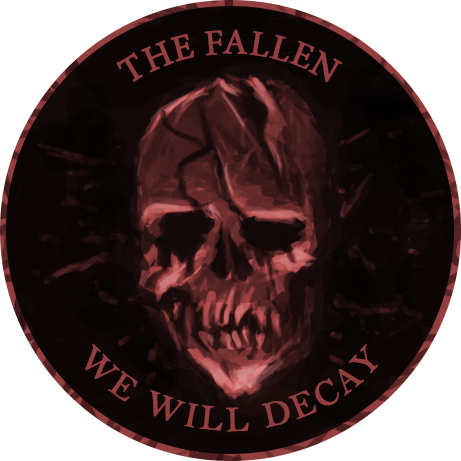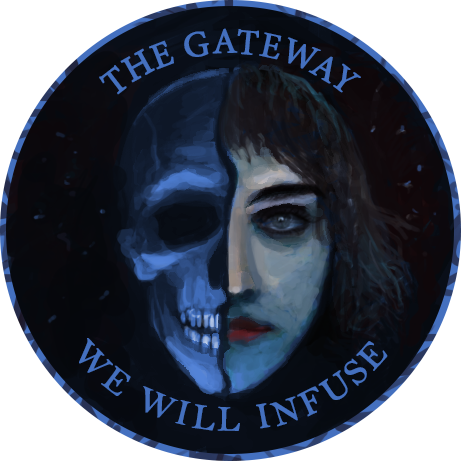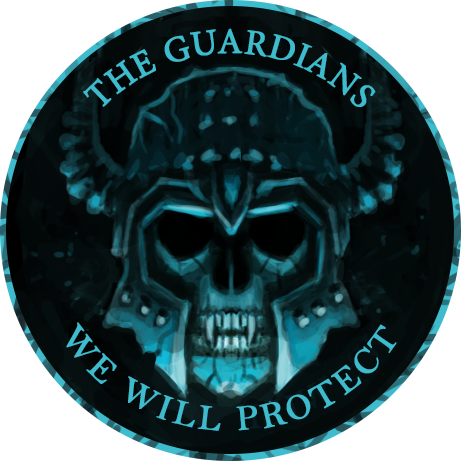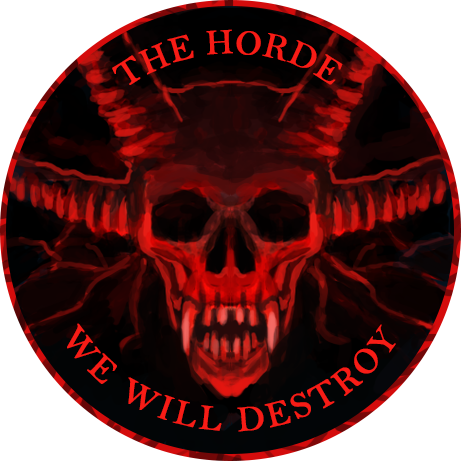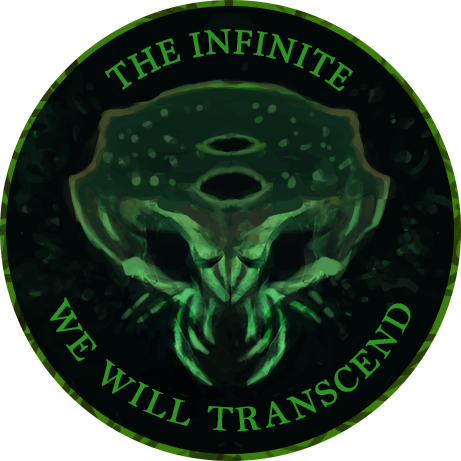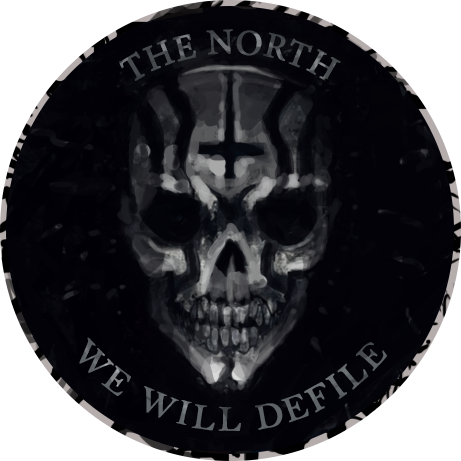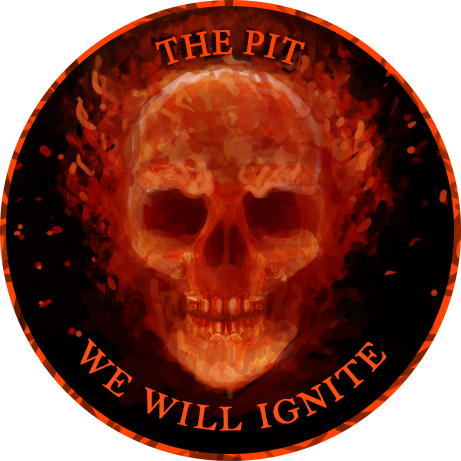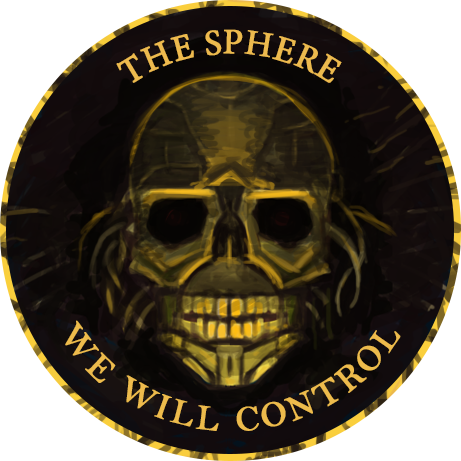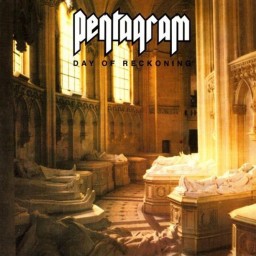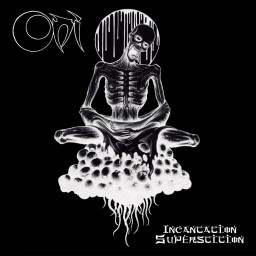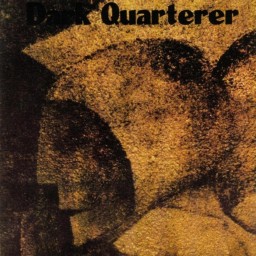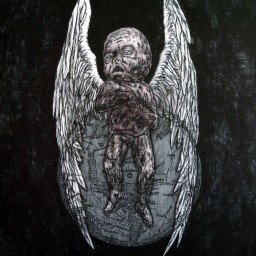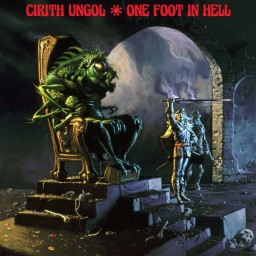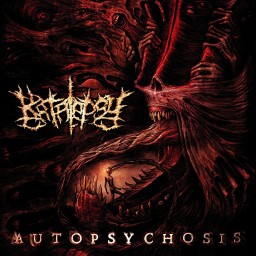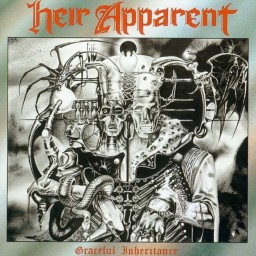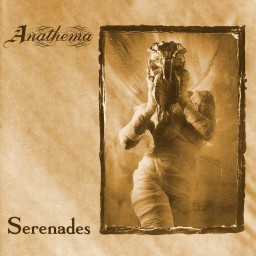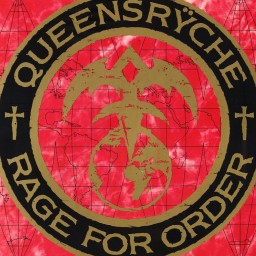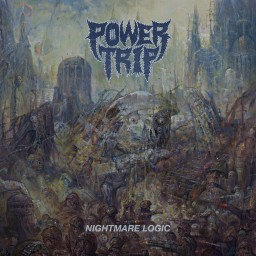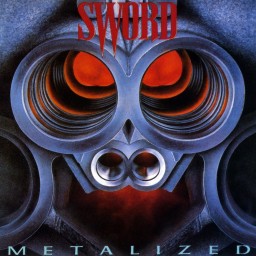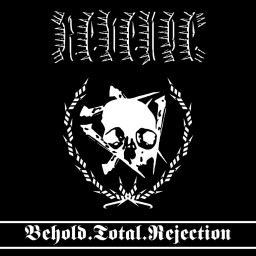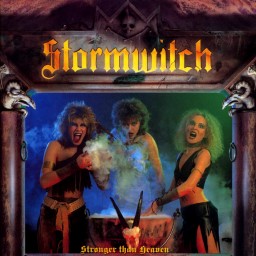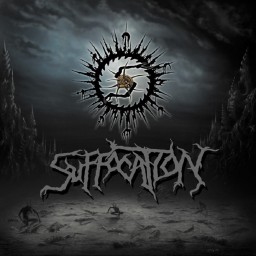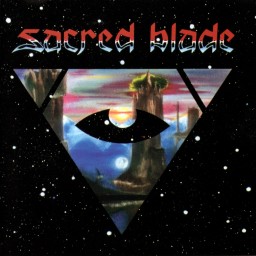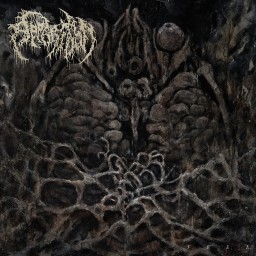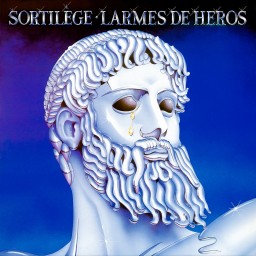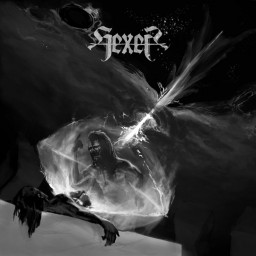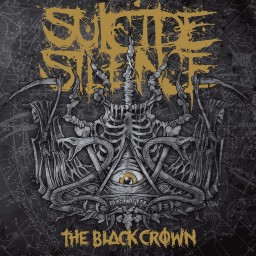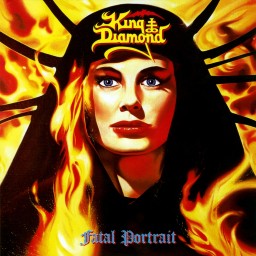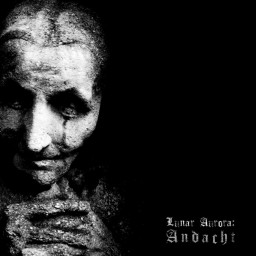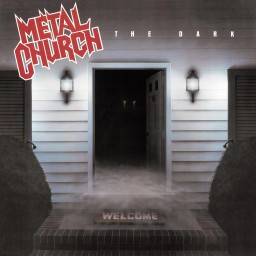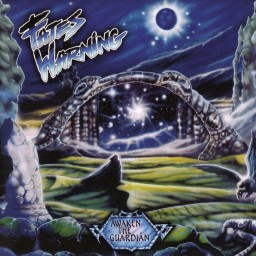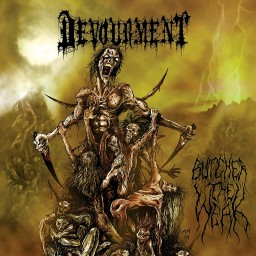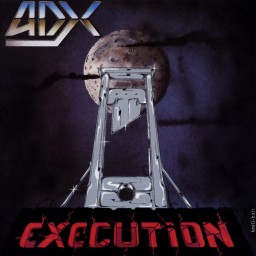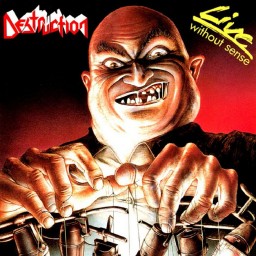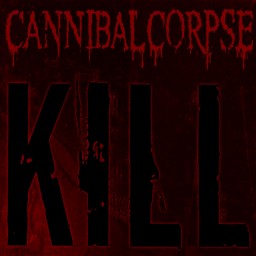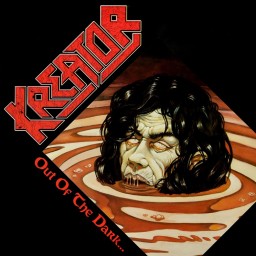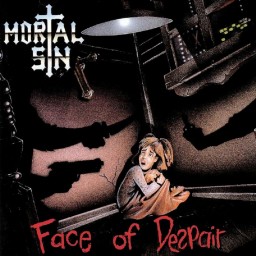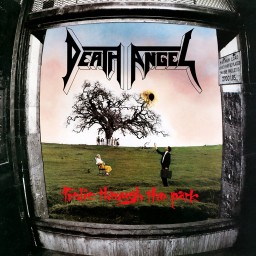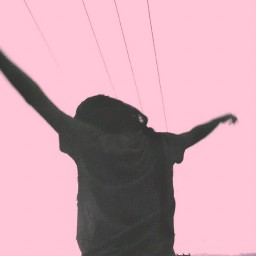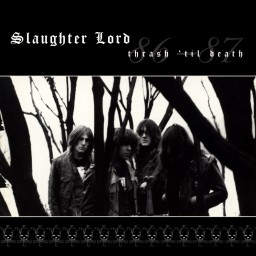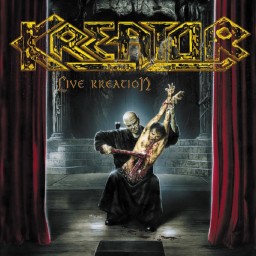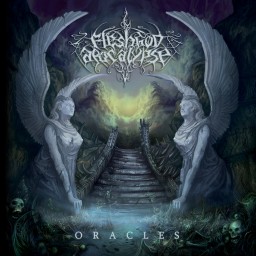Daniel's Reviews
I think it’s fair to say that I became a fan of Virginia-based doom metal legends Pentagram relatively early in their recording career, if not all that early in terms of their overall tenure as a band. The Pentagram story really began way back in 1971 but, given that their debut album didn’t see the light of day until 1985 & I became acquainted with them in early 1990’s, I’d suggest that I was earlier than most, especially when you consider that they’re still a functioning band today. The self-titled debut made a significant impact on me, perhaps more so than I knew at the time. Black Sabbath played a strong role in my formative years through a double compilation that included the best of the 1970’s Ozzy Osbourne releases & “Pentagram” did a fantastic job at tapping into the same areas with a sound that included a little more heavy metal than the band’s traditional doom metal peers. Pentagram weren’t afraid to up the tempo a little while always maintaining their knack for creating the crushingly heavy & guitarist Victor Griffin had clearly mastered the art of creating timeless riffs after a decade or so of studying the godfather of metal Tony Iommi. Despite my allegiances with the self-titled album, my obsession for the extreme metal scene would see me leaving Pentagram back in the early 90’s though & we wouldn’t cross paths again until I’d investigate the “First Daze Here: The Vintage Collection” compilation some time in the 2010’s. I quite liked that collection of Pentagram’s 1970’s hard rock material but it didn’t raise the same level of interest as the self-titled album (also known as “Restless”) did so I haven’t returned to it since. After exploring a slew of mid-80’s heavy metal albums during drive time with my kids of late though I’ve found myself craving something a little heavier which has led me to Pentagram’s 1987 sophomore album “Day of Reckoning” in the quest for the ultimate riff. Let’s find out how it’s faired, shall we?
“Day of Reckoning” is a well composed, executed & produced album that showcases a band that have clearly paid their dues & know their craft well. In fact, the tight instrumental performances & chunky production job for the time really represent a lot of the appeal for me personally as it’s not nearly as consistent a record as the debut was. Pentagram had dropped any semblance of the hard rock sound they’d maintained on the self-titled through tracks like “Run Your Course” & “20 Buck Spin” by this point but I’d suggest that there’s not as much of your pure doom metal sound either with only album highlight “Evil Seed” fully embracing the dark side. The classic heavy metal sound that had perpetuated some of “Pentagram” is toned back a touch here too with the majority of the tracklisting sitting in the murky mid-point that is the traditional doom metal sound. There’s a fair bit of groovier mid-tempo stuff going on here, often hinting at the stoner metal sound that Sabbath had created with their 1972 “Vol 4” album. The use of tightly harmonized guitar melodies pops up quite regularly too & neither of those techniques traditionally sit within my musical comfort zones.
There’s an inconsistency to the tracklisting on “Day of Reckoning” which is in direct contract to “Pentagram” which I found to be without blemish. The album begins very poorly with a couple of numbers that do very little for me in the title track & “Broken Vows”, both which seem to be quite popular but are stylistically at odds with my taste profile. I also struggle with the nine minute centrepiece that is “Burning Savior” with Bobby Liebling’s out of key vocals putting me off through the early stages & the eventual crescendo all coming a little too late. Thankfully though, the combination of the tight performances, solid production & Victor’s undeniable skills as a riff master see the remainder of the record doing enough to recover & leave me with a generally positive feeling by the end of closing track “Wartime”. There are nowhere near the quantity of highlight tracks as its older sibling sported but the wins outweigh the losses to an extent that makes “Day of Reckoning” worth a few listens but I just can’t see myself returning to it any time soon. In fact, I’d suggest that I’m probably more likely to return to the “First Daze Here” compilation than I am to “Day of Reckoning” & I haven’t felt like revisiting that particular release for a good decade or more.
At the end of the day, I think my inability to fully engage with “Day of Reckoning” comes down to personal taste more than anything else. Much like my younger brother & fellow Metal Academy administrator Ben, I’ve never been all that big on the more traditional doom sound as I greatly prefer a more pure, modern & oppressive brand of doom metal. I’ve never really connected with groovy mid-paced stoner riffs but I can appreciate when they’re done well like they are here so there’s enough of interest to keep me going. Fans of Black Sabbath, Saint Vitus & Witchfinder General will likely really dig "Day of Reckoning" but I’m not going to deny that I find it hard to understand the tendency for fans to rate Pentagram’s heavy metal-driven numbers more highly than their slowest, doomiest material which can be pretty amazing in my opinion. If only there was more of it here!
Genres: Doom Metal
Format: Album
Year: 1987
You know what? You can’t get too cocky in this vast & varied landscape that we know as the global metal scene because just when you start to think you know everything there is to know you’re likely to get hit in the back of the head with something you weren’t even aware existed but was right under your nose the whole time & that’s certainly the case with Adelaide-based death metal outfit Oni. I like to think that I have a pretty decent knowledge of the Aussie extreme metal scene (both current & historical) but when I met up with the label head of Sphere of Apparition Records recently he mentioned that the their first major release would be coming from a cool early 2000’s death metal band whose angle saw them tackling themes taken from Japanese demonology. I’d never even heard of Oni before but I trust his judgement so I made a point of checking them out once the CD was released earlier this year.
The ”Incantation Superstition” compilation draws together the entire recorded output of Oni which amounts to two 2001 releases (i.e. the “Enshrined To The Dead” demo & a split CD with delightfully monikered fellow Adelaide outfit Jesus Anal Penetration) as well as a cover version (“Altar of Sacrifice”) taken from the “Hell At Last – A Tribute To Slayer” compilation. Impetuous Ritual vocalist/guitarist & Portal/Grave Upheaval drummer Ignis Fatuus has done an excellent job at remastering & preparing this material as the tracklisting flows pretty seamlessly between the tracks from the various sessions & you won’t experience any jarring changes in sound along the way. The production job is more than reasonable for such old demo recordings too with all of the instruments & vocals being not only clearly audible but also maintaining a suitable amount of raw extremity so all of the ingredients are here for a rewarding trip into the annals of Australian metal history.
The 32 minute runtime kicks off with the five tracks taken from the split CD which I’m assuming is the more recent of the two releases due to its slightly more technical song structures but there’s not really that much of a stylistic difference between the two to tell you the truth which certainly helps with the flow of the tracklisting. The release opens with a short but splendidly executed intro piece that immediately presents the listener with Oni’s Japanese themes before the band blasts off into four hectic & quite brutal death metal outings. This is followed by the three track “Enshrined To The Dead” demo which I slightly favour over the split, especially the last two tracks “Seppuku Blade” (my personal favourite) & “Incantation Superstition” which are particularly strong. The older material might not be quite as psychotic as the material from the split but I feel that it works better from a compositional sense so it offers a touch more appeal for the naïve teenage tape trader that’s still such a big part of me all these decades later. The Slayer cover version represents more of a bolt-on as its style is quite different to the rest of the tracklisting. As someone whose favourite metal album of all time has been ”Reign In Blood” for about 35 years now, Oni was always going to have their work cut out for them in covering a track like “Altar of Sacrifice” which was metal perfection to begin with. They do a pretty reasonable job at replicating the song it has to be said but if you’re going to cover such a well-known & undeniably classic track then you really need to do something a little different with it if it’s to have the desired impact. As it is, “Altar of Sacrifice” comes across as a touch disposable given that it's essentially a down-tuned version of the original & features deep death metal vocals that don’t gel nearly as well as Tom Araya’s did. It’s not a weak song as such but it’s probably the least interesting inclusion on a very consistent tracklisting at the same time.
All of the hints I’d seen online had me expecting to hear something in line with the brutal death metal model when going into “Incantation Superstition” but the reality is a little different to that. Sure, there’s a fair bit of brutality to Oni’s sound but that’s not the only feather in their caps as there’s a lot more going here than that. I feel that the technical death metal subgenre is a much better fit for Oni as their riff & song structures are a touch more complex & a lot more chaotic which brings to mind the more tech death-oriented records from bands like Cryptopsy & Nile. It’s all presented with an inherently underground aesthetic that sees them maintaining enough looseness in their performances to avoid the sterility of the super-precise modern tech death world though. Oni’s riffs are angular & quite jerky at times which never allows the listener to relax. They kinda sound like a runaway train a lot of the time, as if they’re on the brink of crashing but have the technical chops to hold it all together while giving their audience a sly, knowing grin. Despite the technicality though, Oni always keep a foot in the classic death metal camp with “Altars of Madness”-era Morbid Angel appearing to be the main catalyst. The riff structures, blast-beats & super-shredding Trey Azagthoth-style guitar solos all owe a debt to the greatest Florida death metal band of them all although the super-underground atmosphere also tends to have me reaching for comparisons with fellow Morbid Angel disciples Sadistic Intent too.
There are number of Japanese intros & outros used throughout the release & they’re unanimously effective in achieving their desired outcome, so much so that I have to express a little disappointment that I couldn’t hear a little more of the Japanese influence in the actual death metal. I’m sure the lyrics are sporting it in spades but I can’t hear a lot of it in the instrumentation. The band go with several different vocal styles with a deep death growl & a higher, snarlier delivery being the protagonists. I prefer the higher-pitched one for the most part as it sounds less generic & a touch more aggressive. The bass lines benefit from their strong positioning in the mix & make the most of the opportunity by contributing more to the overall package than most death metal bassists are afforded the pleasure of.
Overall, “Incantation Superstition” works very well in paying homage to one of the Australian death metal scene’s less familiar yet still quite talented artists. The continuity of the production job also gives it the opportunity to work as an album in its own right too if you give it the chance. There isn’t a weak moment on the tracklisting & the relatively short run time means that the listener’s patience isn’t challenged which gives the release the potential to reach a whole new audience. In saying that though, I’d probably suggest that Oni’s best work may well have been ahead of them as I’m not quite sure they’d completely galvanized their sound as yet. They’d hit on something fresh & interesting from a stylistic & thematic point of view but I think they needed a little more time (perhaps just in the studio) to pull it all together in a way that’s more unified & fluent so as to truly rip the listener's face off (at least as a full-length release as I do think that "Enshrined to the Dead" is a very solid effort in isolation). As it is though, “Incantation Superstition” has left me surprised that I hadn’t heard of Oni before as local bands of this quality are few & far between, particularly those that possess such a clear pedigree with the extreme metal scene that I love so much.
Genres: Death Metal
Format: Compilation
Year: 2023
The idea of Italian heavy metal trio Dark Quarterer has long been a source of fascination for me to be honest. How they avoided causing any sort of blip on my radar back in the 1980’s & 1990’s but have somehow managed to build such a committed & loyal following over the many years since has left me intrigued as to what they could possibly offer, particularly given the comparisons to some of the more reputable & epically inclined acts from the US scene. I’d never given them a chance up until now though strangely enough so my recent decision to start spoon-feeding my three young kids some less extreme metal releases during drive time seemed like the perfect opportunity for some blind experimentation. It’s proven to be a rewarding experience too, significantly more so for myself than for my kids though it has to be said.
Dark Quarterer’s self-titled 1987 debut album has been gifted with an almost enigmatic reputation in the heavy metal scene. It’s production job is as raw as fuck with the rhythm guitars sitting much too far back in the mix, the vocals trying their best to drown out the instrumentation & a generous coating of distortion layered over the top of everything thanks to some inappropriate use of levels in the studio. Somehow though, this all seems to work to Dark Quarterer's advantage by giving the album an additional touch of underground street credibility but I have to say that I’m a little on the fence about it personally. You see, people are dead right to refer to Dark Quarterer’s sound is being a particularly epic one with bassist Gianni Nepi possessing a soaring voice to rival the most metal claw-inducing power metal front man & the three musicians producing lengthy, layered & extravagant pieces that sit as much in the progressive rock space as they do the heavy metal one. Now, when you take that description into account, I can’t help but feel that a big, clear prog production job might have brought out some additional complexities in Dark Quarterer’s music, even though I can definitely see the appeal in the super-underground packaging too. Perhaps I’m just looking for a little more warmth given that “Dark Quarterer” sounds very much like it was recorded & released in the 1970’s. 1981 would probably have been the very latest I would have guessed this record to hail from in a blind test given that both the prog rock & heavy metal influences are clearly drawn from that era.
In saying that though, Dark Quarterer have still managed to produce a very complex, mature & organic sound for just a trio of instrumentalists. The compositions aren’t technical as such but they are heavily expansive & often improvisational in nature with all three men contributing creatively to the holistic package. Guitarist Fulberto Serena is clearly the protagonist from an instrumental point of view though as these pieces are overflowing with lengthy & quite capable lead guitar solos that any 70’s prog/fusion shredder would be happy to claim as their own. Opener “Red Hot Gloves” sees Nepi’s vocal approach seemingly drawing upon Rob Halford’s efforts on the first couple of Judas Priest albums while the more epic pieces see him achieving quite a bit of crossover with the most epic of the epic in Manowar’s Eric Adams. It all works well too (particularly on album highlight “Gates Of Hell”) & there are no weak songs included on the very consistent 43 minute tracklisting.
Perhaps what holds me back from scoring “Dark Quarterer” a little higher is that it never sounds all that heavy. There are some hints at a doomy edge at times with the vocals occasionally even drawing comparisons with Candlemass’ front man Messiah Marcolin but I don’t feel that the trio ever quite get there, leaving things feeling a touch more mind-mannered than I'd like. The guitar tone doesn’t help as it’s a little more rock than it is metal while the guitar solos I mentioned would fit fairly seamlessly within the context of a prog rock or jazz fusion outfit. Early US heavy metallers Legend are probably a pretty good point of comparison as they always seemed to have one foot in the prog rock/jazz fusion camps & suffered from similar production issues. Dark Quarterer's riffs & vocals are undeniably metal though with their epic atmosphere reminding me a lot of Manilla Road & their heavier, doomier moments touching on Cirith Ungol. These attributes will no doubt appeal a lot more to others than they do to me so I think “Dark Quarterer” is definitely worth a few listens for the discerning listener that enjoys a distinctly 70’s based sound.
Genres: Heavy Metal
Format: Album
Year: 1987
French black metal legends Deathspell Omega may not have clicked with me immediately upon first impressions but they’ve certainly made up for lost time, having gone on to become my favourite modern black metal band for many years now. Admittedly, those first impressions were based on 2010’s extremely dissonant “Paracletus” album which is a hell of a lot to take in for the uninitiated old-school extreme metalhead. It wouldn’t take long for its wonders to open up to me though which saw my affections taking a drastically upward curve, particularly once I discovered Deathspell Omega’s unbelievable array of E.P.’s, many of which would soon sit amongst my black metal records of choice. With all of the talk about their brilliant avant-garde & dissonant material though, it's easy to forget that this band began as a more traditional black metal outfit who was still more than capable of competing with the big boys & their 2004 third full-length “Si monvmentvm reqvires, circvmspice” is a prime example of that.
Now, it’s probably worth noting that my first experiences with “Si monvmentvm reqvires, circvmspice” were taken a little out of context as I’d already flipped out over later & more ambitious works like “Kénôse”, “Veritas Diaboli Manet in Aeternum: Chaining the Katechon”, “Mass Grave Aesthetics” & “Fas – Ite, maledicti, in ignem aeternum”, all of which set an incredibly high benchmark. It’s interesting that I didn’t find myself struggling to connect with “Si monvmentvm reqvires, circvmspice” on the same level though, perhaps because the album takes a much more familiar route via a traditional black metal style that’s somewhat similar to Norwegian icons Immortal a lot of the time. Or maybe it’s that you can very easily see the roots of the band’s fully developed signature sound in this release which is still of an undeniably high quality. I’d suggest that it was probably a bit of both but there’s honestly nothing stopping you from appreciating this record as a solid black metal album in its own right because it’s exceptionally consistent in its delivery.
“Si monvmentvm reqvires, circvmspice” presents thirteen tracks that offer quite a bit of variety without ever deviating from the black metal template. It has to be said that its 77 minute duration is certainly overly ambitious though & I feel that it could have done with a fair bit of culling. In fact, there’s enough elite level material here to have created a genuinely classic 40-45 minute black metal release as the highlights are nothing short of superb. The production job sits well within the confines of the trademark sound Deathspell Omega have built for themselves over the years as it’s cripplingly dark & dense with the powerful drums & Clandestine Blaze/Stabat Mater mastermind & Fleshpress drummer Mikko Aspa’s croaky Abbath-style vocals being the protagonists. The musicianship on display is exceptional as always with former Hirilorn guitarist Hasjarl’s riffs already showing regular signs of the angular approach he’d take on later releases & my beloved blast-beats being performed with the utmost precision. Many of the tracks see wild changes in tempo taking place at various stages & there’s a case for saying that some of the material sounds a little pieced together but you’ll rarely see a moment of respite from the blasphemic atmosphere that pervades the album & this is only further enhanced by the use of religious chants & the sophisticated lyrics which Aspa delivers over the blackened chaos that surrounds him. There’s a supreme confidence in everything Mikko does that never fails to draw me in as he simply seems to know extreme metal music as well as anyone you’ll encounter.
So how does “Si monvmentvm reqvires, circvmspice” compare with Deathspell Omega’s more widely praised & inherently creative material then? Well it’s certainly not inferior in any way. In fact, I’d probably take it over their 2007 follow-up album “Fas – Ite, maledicti, in ignem aeternum” if pushed & it’d just sneak into my top five for Deathspell Omega’s back catalogue overall. The reason I’ve hesitated to reach for my more elite scores goes back to my comments on the length as I find it to be fairly excessive. I mean, what real purpose does closer “Malign Paradigm” serve for example? Is it a weak track? No, it’s actually pretty enjoyable when taken in isolation but its positioning at the end of the tracklisting sees it sounding a little out of place in terms of both style & production, not to mention the fact that it's clearly the least apealling of the thirteen tracks included. The tracklisting would have been much better off ending on the blasting masterpiece that is “Drink The Devil’s Blood” in my opinion. In fact, there are five tracks that I'd happily tag as being genuine black metal classics which is certainly impressive but when you’ve gone for thirteen tracks (none of which are interludes) then you’re always going to risk diluting the overall effect of your best material. Still… I don’t think Deathspell Omega are capable of producing anything that’s not both highly engaging & astoundingly professional so it’s very hard to be too critical. If you enjoy bands like Blut aus Nord, Aosoth & Abigor then chances are you’ll really dig “Si monvmentvm reqvires, circvmspice” too.
Genres: Black Metal
Format: Album
Year: 2004
My experiences with highly regarded Californian heavy metal legends Cirith Ungol have been fairly inconsistent over the years to tell you the truth. I struggled with their 1981 debut album “Frost & Fire” quite a bit, failing to understand the widespread appeal that seems to follow the band wherever they go. It was obviously a much more commercially focused offering compared to later releases though & I found the doomy, Black Sabbath-inspired 70’s atmosphere of their classic 1984 sophomore album “King of the Dead” to sit a lot closer to my musical sweet spot, even if there was far too much filler to see it becoming an essential release in my opinion. That album's more up-tempo material was significantly weaker than the slower, heavier tracks but I liked where Cirith Ungol were going with things so I always intended to follow-up on their 1986 third album “One Foot In Hell” at my earliest availability. Well, I’m afraid that earliest availability has ended up being six or seven years later now but better late than never as they say.
“One Foot In Hell” was Cirith Ungol’s first record with legendary US metal label Metal Blade & I was led to believe that this had resulted in a stronger production job based on the consensus drawn from other people’s reviews. I don’t see it personally as the release has clearly maintained a pretty rough-&-ready, live-in-the-studio aesthetic that kinda buys into Cirith Ungol’s retro-cool vibe, particularly during the more proggy moments where we find the band reaching out into jam territory. There are a lot fewer of those moments than I was expecting here though with the band opting to explore a more straight-forward sound for the most part. There isn’t as many touches on genuine doom metal as I’d hoped here with a good three-quarters of the tracklisting residing in more up-tempo heavy metal territory although when the band do opt to get their Sabbath on we find some of the best parts of the record, particularly on the crushing album highlight “Chaos Descends” but also on “Doomed Planet” to a lesser extent. The lone US power metal number “Blood & Iron” is also pretty strong though which is an indication that I’m simply into a heavier sound if I’m being honest about it.
The tracklisting isn’t the most consistent you’ll find with a few obvious fillers being chucked in amongst the eight tracks & the effects of that are accentuated by the short run time. In fact, much like Judas Priest’s heavily overrated 1977 “Sin After Sin” third album, “One Foot In Hell” is a great example of the "quality canyon" concept, only this time we see it having a greater effect on the overall result with a more than decent start & finish to the album being somewhat ruined by a very poor middle. “Nadsokor”, “100 MPH” & “War Eternal” all sit well below par in comparison to Cirith Ungol’s best material & the album sounds thrown together as a result. Apparently the band’s musical direction was heavily influenced by the label’s demands if we’re to believe the band’s reports & that may well be true because there are a few very simple Motorhead-style heavy metal tunes included that aren’t half as appealing as Cirith Ungol’s more expansive & challenging works. Perhaps it’s that divisive front man Tim Baker simply can’t pull this shit off but I don’t think that’s entirely fair as the song-writing sounds pretty flimsy & lacking in inspiration while Tim at least maintains a level of street-cool that adds a little interest, even if he struggles to fit his wild howls over the top of some of the more accessible song structures. The longer tracks certainly offer more scope for the band to experiment with a few lengthy guitar solos offering some much needed respite.
I’ve been disappointed with “One Foot In Hell” as I expected more from such a highly regarded heavy metal record to be honest. I have no doubt that diehard fans will still enjoy it, as will those with a strong penchant for the more epic 80’s heavy metal acts like Manilla Road, Pagan Altar & Brocas Helm, but be warned that this isn’t half as epic or heavy a record as “King of the Dead” was & it’s not nearly as enjoyable either. I’d probably take it over “Frost & Fire” but not by much as neither are exactly my cup of tea.
Genres: Heavy Metal
Format: Album
Year: 1986
The slam death metal subgenre can be a jarring prospect for even the most hardened of death metallers at times. There are a number of challenges that you must first overcome if you're to connect with this super-extreme form of metal & I have to admit that, even though I’m no doubt Metal Academy’s resident slam death metal aficionado, I still find myself struggling with some of the acts that flaunt the subgenre’s less appealing characteristics in the most overt fashion. The tight, pinging snare drum sound, the ultra-deep, completely indecipherable vocals & the fairly generic slam breakdowns can all be pretty repulsive to the casual listener & I can certainly understand why, even if I’m able to look past these failings for the most part. This is what’s so great about the 2013 sophomore album from Russian five-piece Katalepsy as they’ve chosen to dilute or omit those elements to create a much more agreeable & palatable brand of death metal.
“Autopsychosis” sees Katalepsy drawing almost as much influence from my beloved brutal death metal sound as it does the slam one to be honest which is probably a major contributor to why I like it so much. Current 7.H Target front man Igor Filimontsev’s death growls may be unimaginably deep but they also maintain a monstrous quality that transcends the limitations of slam most of the time & are subsequently a more appealing prospect. The production job is very good indeed & there’s no sign of ping in the snare drum sound at all which is a significant relief to this particular extreme metal nut. The band also reach outside the confines of their chosen genre for inspiration at times, indulging in regular dalliances with the technical death metal subgenre along the way. The flashy burst of technicality may not be the most artistically creative undertakings you’ll find but they do add an additional layer of sophistication to a subgenre that can often sound more than a little dumb. There’s even a fairly melodic progressive interlude included which creates nice change of pace towards the back end of the tracklisting.
There’s a lot to like about “Autopsychosis” actually & it represents one of the better slam releases I’ve encountered. The slam elements don’t sit all that far away from my favourite artists from the genre like Pathology & fellow Russians Abominable Putridity while the more straight-up brutal stuff is in line with Cerebral Bore. You’ll do well to identify any sort of blemish in the tracklisting as the eleven tracks are all of roughly the same quality, making this an extremely consistent release that should tempt more than the odd extreme metal fan across into uncharted slam waters.
Genres: Death Metal
Format: Album
Year: 2013
Seattle-based US power metal outfit Heir Apparent are one of those bands whose name you’ve seen floating around a lot in the metal scene over the years but who very few people you know have actually heard. They seem to have gained somewhat of a cult following for one reason or another but I wouldn’t have had the slightest clue about why before giving their 1986 debut album “Graceful Inheritance” (not a terribly metal title it has to be said) a few spins this week. Having spent a bit of time with it now I feel like I’m starting to get it though.
You see, Heir Apparent are the sort of metal band that appeals to the metal purists out there. They tick a lot of boxes as they’re unapologetically metal, possess some serious chops & are ambitious enough to draw in the prog crowd as well. I’m not sure I buy the whole “US power metal” thing though. One or two tracks of the thirteen tracks included are chunky enough to justify those sort of claims but the vast majority of “Graceful Inheritance” sits pretty close to Iron Maiden’s more progressive mid-to-late 80’s material & the production doesn’t see the album’s overall heaviness doing much to eclipse the NWOBHM in terms of aggression either with the guitar sound being fairly thin even if it is clear & effective. The traditional heavy metal tag would seem to be a btter fit for Heir Apparent in my opinion with three or four songs also meeting the criteria for legitimate progressive metal. I can only assume that it’s the higher register vocals that see people immediately making the connection to US power metal although the added weight of album highlight “Another Candle” & the fairly flat speed metal number “Nightmare” may also have contributed to this misconception.
There’s a general class about everything Heir Apparent do here with all three of the instrumentalists proving themselves to be very capable exponents of their craft. Guitarist Terry Gorle absolutely slays with a whole slew of impressive guitar solos & lead runs throughout the album while bassist Derek Peace (who would also feature on Savage Grace’s 1987 “Ride Into The Night” E.P.) makes full use of a Steve Harris-style position in the mix by showcasing his ambitious & creative technique. Front man Paul Davidson has a pretty good voice for this type of music too but I’m not sure you’d say he competes with the top tier. I could kinda take him or leave him to be honest but he’s not gonna disappoint too many fans of the classic heavy metal sound either.
There’s certainly enough quality on “Graceful Inheritance” to warrant investigation as it’s a very accomplished effort for a debut full-length to tell you the truth. One gets the feeling that Heir Apparent had been very active in honing their craft for the three years leading up to its recording as they offer a level of sophistication that very few US metal bands could match in the mid-1980’s. In saying that though, the song-writing is a little inconsistent as the album isn’t short of filler material, even if there’s nothing truly awful included. Those weaker moments tend to marry up with the occasions when Heir Apparent find themselves settling for more commercially accessible chorus hooks or simpler riff structures a lot of the time too as their strength is in their superior chops & expansive instrumental experimentation. Nonetheless, “Graceful Inheritance” is definitely worth a few listens for fans of Crimson Glory, Fifth Angel & Queensrÿche as it never sounds like the product of a band that deserves to drift off into the distance with very little fanfare.
Genres: Heavy Metal
Format: Album
Year: 1986
Nostalgia is a very powerful emotion. For an obsessive music fanatic like myself it can be so potent that it’s actually kept me from reviewing Liverpool doom/death legends Anathema’s debut album for far longer than it should have. You see, 1993’s “Serenades” (as well as ALL of Anathema’s other 1990’s material) had nothing short of a life-changing impact on my life at the time. There were some seriously hard times during that period of my life including death, drugs, unwanted pregnancy, abortion, adultery, etc. & Anathema represented a place for me to curl up in a ball, wallow in my sorrows, rejuvenate my strength & return to the world with renewed vigor. For this reason, I’ve found the idea of reviewing “Serenades” to be a highly daunting (if not impossible) task. I mean, how could I possibly do it justice? I was well aware that not all of this record was spectacular enough to warrant the five star rating I’ve dished out for it without a hint of hesitation over the years & it scared me to have to deal with that in a way. Perhaps I didn’t want to face a world where “Serenades” is just another record? I dunno but it’s time I overcame my fears in this regard though, if only to ensure that my Top Ten Death Doom Metal Releases of All Time list is a genuine portrayal of the quality of each release.
Ben & I discovered Anathema very early on in their recording career & I regard myself as being very lucky to have done so. 1992’s “The Crestfallen” E.P. was a marvellously atmospheric way to kick things off & saw the band taking huge strides forwards following a couple of crudely produced demo tapes that I picked up through the tape trading scene. Their debut full-length has proven to be much more divisive than the E.P. though & for reasons that I’ve always struggled to understand to be honest. My gut instinct tells me it’s been heavily down-rated by fans of Anathema’s later progressive/alternative rock releases which is a theory that’s pretty easy to believe although there are other factors that come have come into play too. Vocalist Darren White’s mournful death growls can be pretty tough going for those that don’t buy into the sheer hopelessness of Anathema’s depressive, mournful approach to doom metal while the inclusion of a 23 minute ambient piece at the end of the tracklisting is no doubt an insurmountable obstacle for your average metalhead. The album jumps around quite a bit stylistically too as it presents a number of disparate influences throughout its 66 minute runtime. None of these things have proven to be challenges for me personally though. In fact, I genuinely love all of those elements to tell you the truth.
The production job on “Serenades” is pretty dirty which is probably one of those love it or hate it things. Personally I think that the down-tuned guitars benefit from it as it adds to the mournful quality of the album. The rhythm section sounds natural though, particularly the drums which possess an organic depth. The performances are excellent all round with the Cavanagh brothers proving themselves to be the owners of true genius in the way they create complex melodic counterpoints that combine into one devastating harmonic result. This technique has been one that I’ve forever admired & few have ever come close to matching. When they get things just right they can build some truly transcendent & emotionally charged doom metal that reaches into my soul & tears my heart-strings to pieces. This has never been better highlighted than it is on “Sleep in Sanity” which is one of the greatest couple of doom/death tracks ever recorded. The re-recording of “They (Will Always) Die” (which was originally including on “The Crestfallen” as “They Die”) goes very close to matching it too with “Under A Veil (Of Black Lace)” completing a trio of astoundingly high quality examples of their type. The gentle acoustic ballad “J'ai fait une promesse” is just as strong with female singer Ruth Wilson’s sweet tones making me feel like I’m drowning in honey while the epic ambient closer “Dreaming: The Romance” is incredibly well written & executed for a metal band. As an avid fan of ambient music, I have to say that it’s remarkable that Daniel Cavanagh has been able to pull off a work as fully realised & consistently engaging as this monster piece which sees me melting into my environment in a state of satisfied relaxation to cap off what is an immensely important record in my life.
Is “Serenades” the perfect record I always wanted it to be? Well, no I don’t think it is as I can’t say that I genuinely "love" tracks like “Sleepless” & “Where Shadows Dance”. I’ve always found it funny that easily the most popular track on “Serenades” is also it’s clear weak point in my opinion. The gothic rock-inspired “Sleepless” has become a very popular anthem for the band over the years (in part due to its accompanying video clip) but if you look closely you’ll find it to be one of the least significant moments on the album. The clean vocals sound sloppy, the structure is very basic & the more up-tempo metal riffs are not half as compelling as when Anathema reach deep inside of themselves to draw out the darkest memories of the most shattering parts of life. Regardless of what era of Anathema’s back catalogue I explore, they have an uncanny knack for making me feel things that no other metal band can & I can’t see that changing any time soon. "Serenades" offers more of those moments than most as it's built around some incredible highlights. You really need to buy into what Anathema are selling if you’re going to reach their gooey centre though as their complexities are not as obvious as that of their peers who generally don’t reach as far when it comes to structural complexity. If you go nuts for bands like Katatonia, Paradise Lost & My Dying Bride then I implore you not to be put off by the undue criticism of “Serenades” because it’s one of the more special doom/death releases you’ll find. It sits more than comfortably alongside the star-studded back-catalogue of one of the most important bands in my life.
Genres: Doom Metal
Format: Album
Year: 1993
Washington progressive metallers Queensryche became a reasonably big deal in my life around 1990/91 after I stumbled over a couple of songs from their fourth album “Empire” on a late-night metal radio program. I’d quickly go about purchasing the album on CD only to find that it wasn’t as consistent as I’d hoped & relied pretty heavily on those songs that I’d grown to love. Nonetheless, I would soon find myself investigating the band’s now legendary 1988 concept album “Operation: Mindcrime”, a release that commands the respect of any self-respecting metalhead, & it would unequivocally seal the deal for me. My extreme metal affiliations would prove to be too strong for me to spend much time with Queensryche’s earlier material for many years though. In fact, it wouldn't be until Ben & I were running the Metal Academy podcast back in the mid-2010’s, at which time I’d conduct an extensive deep-dive into the 1983 self-titled E.P. & 1984’s debut full-length “The Warning”. Despite being their first proper release, the E.P. served more as a transitional record in my opinion as you can easily see the band moving from a more traditional heavy metal outfit into a more expansive & progressive one across the course of the fours songs. It was still a very solid release though & I thoroughly enjoyed it for its accomplished execution & overall professionalism. “The Warning”, on the other hand, represents perhaps the first genuine progressive metal release & saw Queensryche starting their upward trajectory towards their creative peak in “Operation: Mindcrime”. Sure, there were other releases that saw bands mixing heavy metal with progressive rock influences but none had done it as cohesively in my opinion. And this brings us to Queensryche’s highly praised sophomore album “Rage For Order”, a record that I’ve somehow managed to overlook for all these years.
“Rage For Order” sees Queensryche taking the sound they’d created on “The Warning” to it’s next logical step in what can only be described as a clinical display of classy progressive metal music. The production job is a piece of art in itself as there’s so much packed into it & It'd be remiss of me not to at least entertain the idea that it could be a touch overproduced. This element in itself could be cause for putting off some of your more traditional metal fans as this a very expansive record. The Rush influences that floated around “The Warning” in the shape of rhythmic complexity have perhaps been toned down a touch but the layering & adventure has only been accentuated which makes “Rage For Order” quite a varied & ambitious undertaking. Much like the albums either side of it, it’s baffling that RYM members have tagged it as a Heavy Metal release because it’s certainly not. This is about as Progressive Metal as Progressive Metal gets so NWOBHM fans should think twice before approaching it with the expectation of Iron Maiden worship.
The musicianship on show is nothing short of superb with glistening clean guitar arpeggios, wonderfully melodic guitar solos & inventive drum fills appearing like an everflowing stream & being further highlighted by an array of external influences that give each song its own unique identity. Front man Geoff Tate puts in a masterclass of virtuosic, operatic heavy metal singing & is the clear highlight, particularly those stunning harmonies. As with the earlier Queensryche releases though, I can’t quite see myself reaching the upper echilons of my rating options & it comes down to the consistency of the song-writing. Don’t get me wrong, there are some truly magical tracks included on “Rage For Order”. “The Killing Words” (my personal favourite) & “Screaming In Digital” build into some of the most transcendant pieces of progressive metal I’ve ever encountered & “London” isn’t all that far behind them but these highlights are balanced out with filler tracks in roughly equal measure. There’s nothing weak here mind you but I can’t say that I get anywhere near as much out of material like “Walk In The Shadows”, “The Whisper”, “Surgical Strike” or “I Will Remember”. It’s only Queensryche’s undeniable class that sees them able to pull off some of those songs to be honest.
Regardless of the album’s inconsistencies, I still think it was Queensryche’s best release to the time & have found it to be a thoroughly rewarding experience. They’d take things even further with their next release “Operation: Mindcrime” of course however I’d go so far as to say that I place “Rage For Order” in second place as far as Queensryche’s discography goes these days. Fans of Fates Warning, Crimson Glory & Savatage’s shouldn’t let this one pass them by.
Genres: Heavy Metal
Format: Album
Year: 1986
There’s something to be said for limiting your scope & focusing on execution rather than experimentation & Power Trip’s 2017 sophomore album “Nightmare Logic” is a prime example of what can achieved by taking that approach. I first encountered it shortly after release & was blown away within seconds of the first track kicking off due to the stunning quality of the production & performances. You see, the Dallas-based thrashers don’t try anything remotely different here. They simply nail the shit out of the classic thrash metal model & present it in a wonderfully energetic & vibrant fashion.
Power Trip may have begun life as a crossover thrash outfit but “Nightmare Logic” sees them veering well & truly over towards the thrash side of that equation on this occasion. The aggressive hardcore-style vocals of Riley Gale (R.I.P.) are still one of the major drivers in the Power Trip sound & I find them to be very effective indeed but the instrumentation is more in line with that of Toxic Holocaust, Nuclear Assault & particularly Exodus. There are still certain sections that take a punky route but those parts inevitably line up with the less significant moments on the album so they don’t play anywhere near as important a role as classic thrash does in the grand scheme of things.
The musicianship on show here is phenomenal, despite the band staying well within their limitations & focusing on a tried & true style of metal. The rhythm guitar work is as tight as you’ll find in thrash & benefits from the brilliant production job which is the best I’ve heard in a long time. The real heroes of the record are the rhythm section though, particularly drummer Chris Ulsh who proves himself to be a powerful & talented skinsman. I’d suggest that Chris has spent a decent amount of time at the Dave Lombardo School of Thrash Drumming too as he does a fantastic job at highlighting what were already some fantastically thrashy riffs. The tendency for Power Trip to get a little simplistic & generic in their riff structures is certainly a valid observation but the execution of the band as a tight-knit unit is so on the money that I find it really hard not to get into those moments nonetheless. I can probably take or leave the guitar solos as they're more serviceable than they are dazzling but they serve their purpose nonetheless.
There isn’t technically a weak track amongst the eight on offer but it has to be said that “Nightmare Logic” is a top heavy record because the quality of the A side is much stronger than the B side. In fact, I’d argue that all of the four tracks on the A side are better than the remaining four, particularly the two true thrash metal classics in “Soul Sacrifice” & “Firing Squad” which unapologetically slay this old high-school thrasher. That’s not to say that I don’t enjoy the latter part of the album by any means though so this shouldn’t be regarded as any sort obstacle for your appreciation of what is one of the better modern thrash records you’re gonna find. “Nightmare Logic” well & truly lives up to the hype as far as I’m concerned & I’d suggest that some of our members should give it a second chance because it seems to be a little bit underrated in these parts in my opinion.
Genres: Thrash Metal
Format: Album
Year: 2017
Canadian heavy metallers Sword weren’t exactly a household name around my parts when I was a kid but they seem to have gone on to build a strong following over the years, mainly off the back of their 1986 debut album “Metalized”. I’d certainly been aware of it for many years but had never considered actually exploring it until recently when a couple of very well informed Twitter accounts that I follow started frothing about it. I wondered whether I’d been missing out on an underground gem of sorts so I decided to add it to this month’s playlist.
The early moments of “Metalized” left me feeling a great deal of hope that it might actually be the underground gem I’d been led to believe it is with opening cut “FTW – Follow The Wheel” being the highlight of the album. The production job is remarkably chunky for a mid-80’s debut release & the band’s approach is unapologetically metal with a strong focus on some genuinely heavy riffs & flashy, well-constructed guitar solos which appeals to me greatly. Vocalist Rick Hughes is a very talented front man too so all of the ingredients were there to see “Metalized” justifying the hype. Sadly though, it wasn’t quite able to follow through on its early promise with a consistently impressive tracklisting.
You see, despite the fact that “Metalized” ticks all of my boxes from a sound & performance perspective, the song-writing simply isn’t strong enough to see the album fulfilling its potential. The opener “FTW” is certainly a great way to kick off the record but we don’t see another genuine highlight until the middle of the B side with the very solid heavy metal number “Where To Hide” being a particular favourite of mine. The rest of the album is generally pretty enjoyable with only the very dumb glam metal number “Stuck In Rock” being a clear failure but unfortunately I don’t think that any of the other tracks manage to reach the top couple of tiers of the heavy metal ladder. There is an appropriate level of variety on offer to be fair though. Sword’s main sound is heavily influenced by the US power metal scene with Metal Church, Jag Panzer & Armored Saint appearing to be amongst the major influences but you’ll also find the odd track that changes things up a bit like the Accept-ish “Stoned Again” with its hard rock beats & tempo or closing number “Evil Spell” that sees Sword drawing upon Black Sabbath's "Vol 4" album in what could only be described as an early example of the stoner metal genre. “Outta Control” even takes things up a notch to the speed metal velocities so you won’t get bored through any lack of ambition.
At the end of the day though, there’s a reason that the tier on heavy metal acts have never been matched & it comes down to song-writing. There have been many talented challengers who have taken aim at the stardom of the Iron Maiden’s, Judas Priest’s & Motorhead’s over the years but rarely have they been able to be matched from a pure memorability point of view. Sword are a prime example of this as their sound makes me really WANT to love them but I'm eventually forced to accept that their debut album is more of an also-ran than a genuine contender.
Genres: Heavy Metal
Format: Album
Year: 1986
I came across Canadian war metal solo act Revenge a little late in the game due to my decade-long defection from metal but caught up fairly quickly after my head was unceremoniously removed & stuffed down my neck by James Read’s 2001 “Attack.Blood.Revenge” debut E.P. upon returning to the scene in 2009. That moment of clarity saw me rushing through Revenge’s back catalogue & I’ve kept across their releases ever since. 2015’s “Behold.Total.Rejection” is probably Revenge’s most well-known record though & is arguably their most highly regarded full-length too but I’d never given it the time required to be able to reach a well-informed rating or review until now, perhaps due to the nature of the war metal subgenre itself given that it’s not the sort of thing that requires any sort of deep introspective thinking. I've tended to use the subgenre predominantly for short, sharp shots of adrenaline over the years which is a role that this record is very well equipped to achieve.
On paper, “Behold.Total.Rejection” should really tick all of my extreme metal boxes. It’s unapologetically underground in its approach, it’s relentless in its savagery & it’s as dark as the deepest abyss. Drummer & sole member Read (also of Canadian extreme metal acts Axis of Advance, Blood Revolt, Conqueror & Kerasphorus) takes no prisoners whatsoever as he showcases his power & endurance behind the kit & spits out his lyrics in a manner that’s nothing short of evil. His blast beats are really quite tight for a war metal release. That sort of technical proficiency has never historically been all that high on the agenda for war metal acts with most skinsmen preferring to instil an aura of pure chaos rather than focusing too hard on their timing. Here we see him once again joined by Axis of Advance/Blood Revolt/Sacramentary Abolishment/Weapon guitarist Vermin who has handled all of the guitar & bass duties in a session capacity on many of the Revenge releases & does a pretty good job at it once again too. The guitars are heavily down-tuned in the standard war metal fashion & produce a dark hum that remains intelligible throughout the album which is a nice change from some of Read’s other projects like Conqueror.
The Canadian war metal scene has always possessed a strong grindcore influence & that’s never been as obvious as it is here with the early goregrind sound of Carcass being the main source of inspiration. The use of vocoded vocals is particularly reminiscent of the Liverpool trio but can be a bit annoying if I’m being honest. I’ve never been a fan of artificially enhanced vocals in my metal & this album goes a long way to highlighting why to tell you the truth. It’s the clear weak point of the record for mine. You’ll also notice a Celtic Frost influence in the slower riffs which harness the simplicity & heaviness of Tom G. Warrior’s approach to his instrument to great effect & act as a great foil for the remainder of the record which is unanimously high-paced.
“Behold.Total.Rejection” certainly doesn’t pull any punches in belting the listener around the head but there’s not a lot of substance to it to be honest. I usually go nuts for this sort of thing but this example seems to be missing a layer of musicality in its execution. There’s no doubt that it’s a pretty brutal experience but the vocals often don’t quite gel with the instrumentation & the riffs aren’t consistently special enough to see me regarding this release as essential listening when compared with other Canadian war metal records such as Conqueror’s “War.Cult.Supremacy”. I guess you could say that I like the idea of this record more than I do the reality. Still… it certainly serves its purpose & I can’t see too many Conqueror, Blasphemy or Damaar nuts not having a lot of fun with it.
Genres: Black Metal
Format: Album
Year: 2015
I first encountered German heavy metallers Stormwitch during my research for the Metal Academy podcast back in the mid-2010’s with their 1984 debut album “Walpurgis Night” being the release in question. It wasn’t awful but didn’t offer much more than poorly produced & executed NWOBHM worship, often crossing the line into Iron Maiden plagiarism at times. I got the feeling that the best may yet to come from Stormwitch though, particularly given the consistent praise I'd seen dished out for their 1986 third album “Stronger Than Heaven”, so I penciled it in as one to investigate in the future. That future may have ended up being many years later but here we are. Let’s see what Stormwitch at the peak of their powers sounds like, shall we?
Well, the production job is certainly better than the crude, distortion-drenched debut which is certainly a positive but the music is still pretty unintimidating & melodic, a little too much for my taste to tell you the truth. It’s a very German record in that regard. The Maiden worship is still present but it’s been toned down a little & we’re starting to hear the building blocks of the European power metal movement with some almost poppy choruses & a focus on a more epic atmosphere creeping in at times. That may mean that Stormwitch are starting to mature & find their own sound but they’re also drawing a little further away from my taste profile & I have to say that I preferred it when they were simply copying their NWOBHM idols if I’m being completely transparent.
The lead guitar work has improved remarkably in the two years since the debut as we now see Lee Tarot pulling off some much flashier solos that often represent the high points of some of the songs. Front man Andy Aldrian is serviceable enough but I still can’t say that I see him competing with the big boys of the heavy metal genre. He’s certainly got enough chops to pull off a memorable chorus or two though. The problem is that there aren’t very many decent ones here with album highlight “Slave To Moonlight” being the only one of the eight tracks with strong enough song-writing to see him being given the chance. The rest of the album simply falls a bit flat without ever descending into the genuinely horrible. Some tracks ruin some solid lead-up work with a dull chorus while others simply veer too close to power metal excess for me to really take seriously.
I’m surprised at just how popular “Stronger Than Heaven” is to be honest, especially given just how awful it’s front cover is. I can only imagine that it’s received more attention than it’s worth due to it’s influence on the early German power metal scene. I haven’t read anywhere that that was the case though. It’s just a hunch I’ve got as the band’s sound seems to possess many of the traits that we’d see popping up from Stormwitch’s countrymen in the coming years. It’s far too clean-cut an album for my taste though & if pushed I’d probably take “Walpurgis Night” over it which isn’t much of an endorsement for its quality & appeal. I'm sure that fans of bands like Sortilege, Oz & Running Wild will likely disagree with me though so if that sounds like you then you may find a lot more appeal in "Stronger Than Heaven" than I have.
Genres: Heavy Metal
Format: Album
Year: 1986
How good are favourite bands then? In fact, I’d go so far as to say that I quite often enjoy my favourite bands more than other bands which is interesting, isn't it? They just seem to appeal to me a little more for one reason or another & New York death metal legends Suffocation have been the long-time leader of that pack as their sound & technique is simply so in tune with my own view on what extreme music should be. I’ve made no secret about the fact that Suffocation’s classic period is about as good as metal gets for me personally but what makes them sit in such a prominent position in my affections is the quality of lesser known releases like this one, the second full-length after their solid return to the scene through 2004’s “Souls To Deny” album.
The general consensus around 2006’s self-titled record has always baffled me to be honest. Sure, it doesn’t try anything terribly new & tends to reside primarily in realms that Suffocation had built for themselves more than a decade earlier but it just does what it does so fucking well guys. I truly believe that the only difference between a merely decent Suffocation release & a truly mind-blowing Suffocation release is the quality of the production job because I don’t think they’re capable of writing anything that’s not ridiculously strong. They sit way too far above the competition for that.
And when I say “they” I’m really talking about chief song-writer Terence Hobbs & front man Frank Mullen because they’re the only band members to have stayed the entire course yet Suffocation continue to churn out records that… well… sound exactly like Suffocation. Unlike the AC/DC’s of the world though, I find that I can not only handle another helping of exactly the same shit as Suffocation have dished up several times before but I go back for triple helpings. A lot of the reasoning behind that can be attributed to the fact that bands of this ilk simply don’t come around very often. There’s a class about Suffocation that literally no one can touch, including the highly regarded peers that they’re generally compared with like Dying Fetus, Cryptopsy & Nile. The incredible knack for balancing brutality & complexity within their riff structures could have come from no one else & those twisted yet highly expansive chromatic guitar solos are a clear trademark (check out the lengthy one that makes up the entire mid-section of "Abomination Reborn" for an example of one of Terence’s best). Despite my close affiliations with the brutal death metal scene, I've always preferred a bit of intelligibility in my death grunts too & Mullen is the best example you'll find as he somehow manages to achieve monstrous savagery while still allowing the listener to understand the message behind some pretty imposing lyrical content (see "Entrails of You" for example).
If we take a look at the self-titled album in a little more detail though, the first thing that’s worth mentioning is that (unlike “Souls To Deny”) they’ve got the production right this time. As soon as I heard that I knew that I was in for a devastating journey & indeed that’s what I received. Short, hellish intro track “Oblivion” is perfectly suited to introducing the annihilation that’s to come with opener “Abomination Reborn” being one of the band’s most brutal offerings & highlighting powerhouse drummer Mike Smith’s incredible strength & endurance in no uncertain terms thanks to an ultra-heavyweight drum sound. It’s a great way to kick off the record. Things settle down for a few tracks from there with some solid & muscular outings that don’t disappoint but can’t quite match the dizzying heights of their opener. By the time we hit the midpoint of the tracklisting though, order has been well & truly restored with four of the next five songs being elite examples of the brutal death metal subgenre, particularly “Translucent Patterns of Delirium” (my personal favourite) & “Regret” which are nothing short of perfect in my eyes. The album closes with the now obligatory rework of a song taken from Suffocation’s poorly produced “Breeding The Spawn” record in “Prelude To Repulsion” which easily manages to eclipse the original version. It does sound just slightly out of place here though as it’s both a lot more consciously technical & a touch less chunky & brutal than the other nine proper songs.
At the end of the day, I can’t imagine why any true Suffocation or brutal death metal fan wouldn’t completely flip out for this stuff to tell you the truth. Some tracks have less impact than others but the highlights are so strong that I’ve found it hard not to continue to return to this release repeatedly over the 14 years since I first encountered it. Does it compete with the band’s classic period releases? You know what, it might not be a match for Suffocation’s most accomplished & ultra-premium works (“Pierced From Within” & the “Despise The Sun” E.P.) but I wouldn’t place it too far behind classics like “Effigy of the Forgotten” & the “Human Waste” E.P. if I’m being completely honest. I think some of that comes down to the fact that those releases don’t sound quite so fresh these days due to the unmitigated flogging I’ve given them over the years as well as the slightly more polished & modern sound that the self-titled benefits from but don’t let this one pass you by if you have even a passing interest in this band or in brutal/technical death metal in general.
Genres: Death Metal
Format: Album
Year: 2006
The sole proper release from Canadian metal band Sacred Blade seems to have become somewhat of an underground classic over the years although this is my first time experiencing it for myself. I’ve always found the idea of this record intriguing as it’s generally regarded as one of the earlier examples of genuinely progressive metal to surface from the global scene along with other mid-80’s releases from bands like Fates Warning, Watchtower, Queensryche & Siren. I’ve read next to nothing about the finer details of the release over the years though so I had no idea of what to expect going into “Of The Sun + Moon”.
Sacred Blade went with a four-piece line-up for their debut full-length with front man Jeff “The Pilot” Ulmer also handling a number of instrumental bits & pieces including percussion & keyboards. Their sound is quite varied & I’m tempted to describe it as combining the progressive metal of Fates Warning with the US power metal sound of Crimson Glory only the prog comes from more of a prog rock direction than a prog metal one in a similar way to early US heavy metallers Legend. The guitar work is a touch more aggressive than any of those bands though, occasionally veering into speed metal & thrash metal territory. Now, when I say “progressive” I don’t mean “technical”. I’m really referring to Sacred Blade’s more expansive take on the heavy metal sound with lots of creative elements being thrown into the mix to provide additional highlights above & beyond the usual US power metal trappings. For example, there are a number of short(ish) interludes that veer away from metal as well as plenty of acoustic guitar flourishes & interesting layering of instrumental parts.
It's pretty clear that Sacred Blade are capable musicians on the evidence here but what’s also evident is that they weren’t exactly cashed up because the performances aren’t amazing. The skill sets are obvious but there are a number of mistakes that have been left in, presumably through a lack of the required studio time to redo them. The production job is actually really good for the time though & Sacred Blade generally sound pretty heavy. Their Achilles Heal is certainly in the vocal department though as Ulmer simply can’t sing to put it bluntly. “Of The Sun + Moon” could potentially have been a pretty awesome record if not for his off-key inadequacies which have been placed surprisingly high in the mix too. I’m shocked that the producer wasn’t aware of this failing & didn't try to hide it a little by pushing him back in the mix a touch. I mean, those attempts at high-register Rob Halford screams in “Salem” completely ruin it for me. Thankfully the tracklisting ends with what I regard as it's two best inclusions with heavy metal number "In The Light of The Moon" possessing the hooks to overcome Ulmer's limited range & lengthy (& perhaps not surprisingly mostly instrumental) progressive metal closer "Moon" being my clear album highlight.
All things considered, “Of The Sun + Moon” offers some really ambitious & creative US power metal style heavy metal that could have been something really special with a little more attention to detail. As it is though, I still find it to be an interesting listen, just not one that I can see myself returning to due to the vocal deficiencies. It would seem that many people are able to look past those in claiming the album to be a genuine 80’s metal classic though which I find hard to fathom.
Genres: Heavy Metal Progressive Metal
Format: Album
Year: 1986
I’ve certainly been aware of Los Angeles death metallers Apparition since this release saw the light of day a couple of years ago & have been meaning to give it the attention required to develop a firm opinion on it ever since so it’s great to finally have the opportunity gifted to me via this month’s feature release nomination. You see, Apparition certainly sound like my cup of tea on paper. Dank & swampy sound? Tick! Underground integrity? Check! Decent production & performances? Uh-huh. Capable song-writing? Yep! But sometimes all of those things strangely don’t amount to a positive experience for one reason or another. Everything just needs to gel & thankfully that’s what happens with “Feel” because I’ve really enjoyed the ride.
Let’s get one thing straight. Apparition don’t try to reinvent the wheel in any way, shape or form. You won’t find anything that you haven’t heard before on “Feel” & the more elite death metal acts have arguably done it better too. But if you love the darker, doomier end of the death metal spectrum then you’re probably unlikely to care much about the lack of originality anyway because Apparition know what good death metal should sound like & have managed to reproduce it here.
The descriptions of the album as sitting between your classic death metal sound & the doom/death subgenre are accurate although there’s little doubt that Apparition sit far closer to the death metal side of the equation with Incantation being a pretty reasonable point of comparison. There’s a measured feel to the riffage though that sees the band never taking off into relentless blast-beat territory. Instead we find them staying relatively within themselves & focusing on tight, chunky, memorable riffs. Do they succeed? Well yeah… for the most part. There are certainly a few brief missteps along the way but the majority of this stuff is highly enjoyable. I do have to admit though that I prefer it when Apparition get their doom on, particularly when they add a touch of atmosphere like they do with the inclusion of some subtle keyboards at the end of the wonderful album highlight “Nonlocality”.
Apparition’s sound is as much the drawcard as the actual songs though to be honest as they’ve been very successful at replicating that grimy graveyard atmosphere that all members of The Horde should be able to relate to. The vocals of drummer Andrew Morgan are deep & monstrous while the guitars of Jnut (who is also in Californian crossover thrash outfit Dead Heat) & Deadbody axeman Miles McIntosh are very tight & opt to slowly engulf the listener rather than brutally assault you. These are very positive attributes for a death metal-based release so, despite a couple of the six tracks not being all that amazing, I can’t say that I’m ever left feeling that there’s a noticeable blemish on the consistency of the tracklisting so I don’t think there’ll be too many disappointed fans of doomy death metal walking away from “Feel” with a negative impression. Apparition know what they’re doing & they do it well. There’s no progressive wankery or expansive experimentation going on here. It’s a death metal for death metal’s sake affair & I for one have no problem with that at all.
Genres: Death Metal Doom Metal
Format: Album
Year: 2021
My previous experiences with premier French heavy metal outfit Sortilège have never been very enjoyable to tell you the truth. I spent a fair bit of time with their supposedly classic 1983 self-titled E.P. & their 1984 debut album “Métamorphose” back in the mid-2010’s as a part of my research for the Metal Academy podcast but discovered that I struggled to connect with either. I found the overly theatrical French-language vocal delivery of front man Christian Augustin to be quite a challenge at times (particularly when he bordered on power metal schmaltz) while the song-writing could verge on the cheesy at times too. They certainly weren’t the heaviest or most aggressive of metal bands either so the result of the exercise was that I ended up placing Sortilège in the “none of my business” box alongside bands like Anvil, Helloween & Loudness. Admittedly, the more complex song-structures of “Métamorphose” did show more promise than the blatant NWOBHM worship of the E.P. though so the completist in me could never quite shake the feeling that perhaps Sortilège’s highly regarded 1986 sophomore album “Larmes de héros” would be the one that finally saw my eyes being opened to the wonders that the rest of the global metal scene were already so aware of. So here I am… leaving myself open & vulnerable… the fate of my morning at the mercy of five mysterious yet highly capable French chaps.
You know what though? “Larmes de héros” ain’t half bad if I’m being honest. The added technicalities of “Métamorphose” have been left behind in favour of a stronger focus on song-writing which sees Sortilège reaching a new level of maturity in my opinion. There are still a few obvious filler tracks included but, unlike the band’s previous efforts, the wins easily outweigh the losses & I’ve been left with a positive feeling overall. The weaker moments definitely line up with the more up-tempo & generic NWOBHM inspired material while the best tracks are clearly the ones where Sortilège slow things down a bit to give them more room to move with Augustin’s undeniable vocal talents reaping far more reward with a little space around him. Just check out his stunning harmony work in “Quand un aveugle rêve” for example. Or try to stop yourself from banging your head during the doomy Black Sabbath inspired album highlight that is “Marchand d'hommes”. Not to mention the impeccable talents of lead guitarist Stéphane Dumont who can match it with the best shredders around.
So look, Sortilège is never gonna be one of my favourite bands but closing out my knowledge of their big three releases has proven to be a worthwhile experiment. “Larmes de héros” may not possess a glossy high-budget production job but the song-writing is strong enough to overcome the fact that the rhythm guitars sound thin & are too far back in the mix. Don’t be put off by the lacklustre opener “La hargne des tordus” or the very ordinary “Mourir pour une princesse” or “La huitième couleur de l'arc-en-ciel”. Have some faith & give the record time to dig its claws in. You may just find that it offers some quality heavy metal, particularly if you dig NWOBHM-influenced heavy metal artists like Ostrogoth, Stormwitch or fellow Frenchmen Blasphème who all tap into a similar vibe.
Genres: Heavy Metal
Format: Album
Year: 1986
I hadn’t actually heard of German doom/sludge metallers Hexer before this month’s feature release. Sonny has a habit of identifying interesting & ambitious underground acts in the depths of our The Fallen clan though so I went into the band’s 2017 debut album “Cosmic Doom Ritual” with a positive outlook & have been thoroughly rewarded for it too as it turns out. You see, Sonny & I share a passion for psychedelia & when combined with metal in subtle ways it can create a truly transcendental experience. These sort of records require a great deal of patience though as they rarely give up their full array of gifts without repeat listens. You really do need to be in the right headspace to allow yourself to be engulfed by the swirling atmosphere as repetition is used as a basic building block of the composition & the hooks aren’t always obvious.
After coming fully to grips with “Cosmic Doom Ritual” over the last couple of days, I’ve come to the realisation that Hexer have fooled many people because the use of the word “doom” in the album title has led most online resources to claim the album as doom metal. In reality though, the tone is much more abrasive & the vocals are a lot harsher & more aggressive than you would usually expect from doom which sees the release aligning itself pretty clearly with sludge metal. The use of slowly building post-rock song structures & stripped-back atmospherics is far in excess of what you will find on a conventional sludge release though with the band taking a more textured approach & steering away from the standard riff-fest. For these reasons, I see “Cosmic Doom Ritual” as a post-sludge metal release with references to stoner metal in the psychedelics. It’s very similar to another one of Sonny’s favourites in MSW’s “Obliviosus” in that way & I’m pleased to have discovered that it’s just as successful in the endeavour too. The Ufomammut references that some of you have mentioned are certainly relevant too. There are some faster blasting sections utilised at times only in more of a hardcore context than a death metal one although the vocal delivery does occasionally edge a little closer to the border of death/grind than most sludge front men dare. If I’m being particularly picky I’d probably suggest that the vocals are the weakest component of the album to tell you the truth but thankfully the instrumentation is so engaging that it’s not all that relevant a point. The bass tone is of particular note as they’ve managed to nail that full yet inherently dirty sludge sound to a tee.
“Cosmic Doom Ritual” consists of three lengthy tracks, all of which are of a high quality & possess their own unique character traits which is an important element of any great record. The second track “Pearl Snake” is the real classic of the three & was the deciding factor in me awarding the album one of my elite scores. The way that track builds & develops through various different timbres & atmospheres is phenomenal & inevitably leaves me feeling exhilarated. The other two inclusions are both strong though with the post-rock sections being particularly well executed so I’ve been really pleasantly surprised by this record. I’d recommend it to all members of The Fallen & The Infinite with a taste for a psychedelic metal sound.
Genres: Doom Metal Sludge Metal
Format: Album
Year: 2017
I’ve been following Australian extreme metallers Nocturnal Graves for some time now, particularly since seeing them play live in support of Mayhem & Watain back in 2014 where they thoroughly impressed me. The Aussie scene is known for producing bands that tip toe along the borders of all three of the major extreme metal genres (i.e. death metal, black metal & thrash metal) with the state of Victoria arguably being the epicentre for that sound. Many of the bands from that region tend to share members & it’s not hard to connect all of them together if you put your mind to it so Nocturnal Graves stem from a long line of seminal artists & possess an imposing pedigree of their own. You can easily hear that in their sound too as they clearly know what it is that made the legendary bands of our youths so great.
Nocturnal Graves is really the brainchild of multi-instrumentalist Jarro Raphael who handles the vocals, rhythm guitars, bass & drums on “An Outllaw’s Stand”, the band’s fourth & latest full-length album. Jarro cut his teeth drumming in a couple of other prominent Aussie extreme metal bands in Destroyer 666 & Destruktor before heading off on his own. He’s joined here by a couple of talented lead guitarists in Denouncement Pyre main man Decaylust & current Razor of Occam & former Destroyer 666 & Adorior axeman Shrapnel who I had the pleasure of partying with back in 1996 when he was still one of K.K. Warslut’s sidekicks. The three of them make for an imposing trio & have produced one seriously underrated & high quality record here.
Nocturnal Graves are generally tagged as blackened death/thrash & you can easily see why upon first listen to “An Outlaw’s Stand” however I’d argue that the links to thrash are misguided on this occasion which makes the album an uncomfortable fit as a feature release for The Pit. There are certainly some thrash influences here & there but this is much more of a blackened death metal record in my opinion with the two primary genres sharing the spotlight in roughly equal measure. Perhaps the links to thrash come from the similarities in approach to Sweden’s Witchery & fellow Aussie bands like Destroyer 666 & Vomitor whose blackened sounds are more heavily infiltrated by classic thrash but personally I’d suggest that there’s a lot more Sadistic Intent & particularly early Morbid Angel in Nocturnal Graves sound than there is the thrash metal of Slayer. At times they even hint at the war metal of Bestial Warlust which can’t be a bad thing now, can it?
On paper this sort of stuff should really appeal to someone like myself & I’m very pleased to advise that “An Outlaw’s Stand” delivers on it’s promise with a metal-at-all-costs onslaught of darkness & chaos. There are blast-beats aplenty to accompany some seriously evil blackened vocals & a plethora of Trey Azagthoth-inspired lead guitar work that steals the show from the band leader on this occasion. You’ll do well to find a record that’s more inherently metal than this one as it ticks all of the boxes. Unfortunately it’s perhaps not quite sophisticated enough to be competing with the top tier though, despite having created a mighty maelstrom of an atmosphere. I think Raphael sometimes keeps the beats fairly simplistic in the interest of underground credibility & the results are a little mixed without ever losing momentum. The lead guitar tone seems to have been consciously aimed at replicating that classic Morbid Angel sound with ample use of wah pedals having been employed in the interest of bringing some additional tension & fire to the game. I have to say that it’s worked marvelously well too.
“An Outlaw’s Stand” is an undeniably underground record for those who remember what the scene was like in the late 1980’s & early 1990’s. It doesn’t try to reinvent the wheel, instead electing to borrow their components from the true greats & presenting them in their own way. It works unanimously well too although I have to question the programming of the tracklisting given that the two best tracks on the album are left right to the end. It certainly leaves me wanting more but wouldn’t it have been a better option to place one at the start in order to give the record an added push right from the offset? I would have thought so. Still… it defies all logic that RYM currently has this release sitting at an average of 3.1/5 after almost 200 ratings. Are we listening to the same record??
Genres: Black Metal Thrash Metal
Format: Album
Year: 2022
I’ve probably mentioned this in a previous review or two but the treatment of the extremely divisive subgenre of metalcore known as deathcore was one of the original catalysts for me being passionate enough to pursue the Metal Academy cause. I’m not saying that I absolutely love the subgenre by any means but its almost unanimously poor treatment amongst the more elitist end of the metal underground has always been something that's urked me, apparently enough to make me want to make a stand about it too. You see, there’s simply not much wrong with deathcore when compared with other more respected genres of extreme metal. The main gripes with it are around it’s genericism & lack of sophistication yet those same critics will then go off & rave about the next old-school Carcass clone which defies all logic. At the end of the day I just want fairness & equality for everyone in this vast global community & it’s often very hard to come by when the likes of Metal Archives refuse to accept a record like this one as metal & the RYM masses are rating it a ridiculous 2.49/5 from over a thousand votes simply because it is was it claims to be on the tin. None of this makes sense & has made it virtually impossible for deathcore fans to be able to sift through the zillions of also-rans in order to find the cream of the deathcore crop. That’s where Metal Academy came in….
Anyway… let’s not dwell on that much more & get on with the review. I went through a period of deathcore exploration from 2009 through 2012 after returning to metal from a decade spent indulging in electronic music. Part of that was due to the fact that I was used to an aggressive & brutal riff-based style of metal & was finding that a lot of the popular extreme metal releases of the time were more expansive & experimental & utilized many external influences such as post rock & shoegaze. As I was getting my head around all that, I needed something more easily palatable to take out my aggressions & deathcore was one of the sounds that fit the bill. Was it generic? Shit yeah it was but it was generally beautifully performed, professionally produced & savage as fuck so I didn’t give two shits. I didn’t find myself labelling too many deathcore releases as metal classics but not every record has to be to be worthy of my enjoyment. Suicide Silence appeared on my radar fairly late in that experiment but their 2012 third album “The Black Crown” seemed to stick more than most others. The chunky riffs, relentless vitriol & clean production all worked together to ensure that I gave the album a good number of repeat listens that year & has also seen it managing to hang on to a position in my Top Ten Deathcore Releases of All Time list to this day.
So why does “The Black Crown” get so badly slammed by the metal community even when compared with Suicide Silence’s earlier releases then? This is the only Suicide Silence release I’m familiar with so I can only guess but I assume it’s because this album saw the band exploring the influences they picked up in their youth a little more than they may have in the past, some of which could be regarded as a precursor for the unanimously panned self-titled 2017 album which by all reports saw them fully embracing a nu/alternative metal direction for a short while. While “The Black Crown” certainly achieves a nice balance of death metal & hardcore punk (which is a little heavier on the former if examined closely), it’s pretty clear that Suicide Silence were raised during the 1990’s & they aren’t afraid to show it on this occasion so you’ll no doubt pick up the odd groove-oriented Pantera riff or a few Korn-style nu metal chuggers throughout the tracklisting, not to mention short smatterings of progressive melodicism. It seems to be a trend to slam groove metal & nu metal in the underground metal scene these days (Thanks Metal Archives/Reddit!) but most of us were partial to records like “Vulgar Display of Power”, “Chaos AD” or “Korn” back in the day if we’re being honest with ourselves so it seems to me to be a little hypocritical to criticize others for wearing their roots on their sleeves, especially when the band are all such talented musicians who really know what they’re doing so pull it all off with aplomb. Drummer Alex Lopez was clearly trained at the Vinny Paul school of rhythm when it comes to accentuating the physical reaction from a riff without overplaying his hand & his blast-beats are absolutely on point. I really enjoy the lead guitar work which is quite accomplished too.
“The Black Crown” would sadly be the last Suicide Silence album for front man Mitch Lucker as he’d tragically lose his life in a motorcycle accident later the same year but he will certainly be the other stumbling block for your average death metal fanatic. I mean if you don’t like deathcore vocals then you’re not gonna like “The Black Crown” because he’s everything your average deathcore front man aspires to be. He screams out his lyrics with complete disregard for any sort of etiquette or class & is more brash & overbearing than he is authoritative. I have to admit that I can stomach him pretty easily though & I think that comes down to the fact that I’ve become more & more attracted to super-angry hardcore in my old age.
All things considered, a four star rating would still seem to many to be pretty high for a release like this one so what’s my justification? Well, I guess I just love genuinely aggressive metal that’s performed by capable musicians & produced with precision & professionalism. It’s really that simple. The riffs may not be terribly original & the plethora of breakdowns may be predictable but sometimes I don't need much in the way of originality & just wanna thrash out so “The Black Crown” fits the bill nicely. I can’t see why fans of bands like Whitechapel or Impending Doom wouldn’t find plenty to enjoy here too.
Genres: Metalcore
Format: Album
Year: 2011
I've always enjoyed the more classic King Diamond & Mercyful Fate releases but recently realized that I'd never actually heard King Diamond's highly regarded debut album & decided to fill that gap post haste. Unlike most people, I've always slightly favored the King's solo material over Mercyful Fate & "Fatal Portrait" again showcases the reasons why with guitarists Andy LaRocque & Michael Denner contributing dazzling performances that steal the show from their theatrical front man. The lead guitar tone is nothing short of wonderful & the solos are pushed way forward in the mix for obvious reasons which is a major drawcard for this old shredder. The rhythm section of Timi Hansen & Mikkey Dee are pretty sensational too as they effortlessly pull off some pretty classy instrumental nuances so efficiently that a lot of the more technically impressive touches probably go unnoticed by most listeners. I can generally take or leave the King's operatic vocal style to be honest though. He can be pretty amazing on the super-elite classics but doesn't really do much to draw me in on the rest of the material & I kinda feel that I've heard it all before from him at this point in my life.
Despite a few flashy flourishes here & there, I'd suggest that "Fatal Portrait" is probably a little less progressive than some of the King's other albums & thankfully isn't as neoclassically influenced either. The highlight tracks like "The Candle", "The Portrait", "Charon" & "Haunted" are all very strong heavy metal anthems in their own right but I'm not sure I can say that any of them are genuine classics for me personally & I think the King is the limiting factor there as I really do need to be able to connect with the vocal hooks in your more traditional heavy metal space. There are plenty of outstanding riffs but I think they've been done a minor disservice by not being afforded a more prominent position in the mix to be honest. I would have liked to see them being more of a highlight alongside the solos.
At the end of the day "Fatal Portrait" is a pretty good King Diamond record that ticks all of the boxes that diehard fans could want. I'm not particularly interested in the lyrical themes & I think that's to my own detriment when it comes to the King as it seems to be a large part of his appeal. There's only the one weak track in the disappointing "Dressed In White" but it was just enough to see me dropping my score a touch. That being said, I'd suggest that this record might still just slip into my top five King Diamond-related releases & I'd actually take it over more highly regarded albums like "Don't Break The Oath", "Them" & "The Eye" so it's definitely worth a few listens, particularly for fans of occult-themed heavy metal bands like Mercyful Fate, Ghost & Death SS.
Genres: Heavy Metal
Format: Album
Year: 1986
I've had a lengthy relationship with German black metallers Lunar Aurora after first discovering their first two studio albums through the tape trading scene in the mid-1990's, both of which I quite liked without ever being tempted to claim them as essential. I wouldn't return to Lunar Aurora for more than a decade after that, finally catching up with them again with 2007's "Andacht" around 2009 & being suitably impressed with the improvements Lunar Aurora had made to their sound over the years. "Andacht" sees Lunar Aurora reaching somewhat of a peak in their quest to create a more atmospheric soundscape than I remember from their early works with the use of keyboards being prominent but not overused. The use of drum programming is noticeable but fairly well executed & certainly not intrusive. The more aggressive moments are the most enjoyable for me personally which is hardly surprising. There are a few sections where the band move in a direction that kinda resembles folk metal without actually using those cheesy folk melodies & they represent the weak points of the album. Some of the more keyboard-heavy sections can sound a touch overblown too & (as is often the case with me) the most popular song on the record "Findling" is also the one that I find the least appeal in. Regardless of that, the majority of the six tracks are very strong examples of the atmospheric black metal subgenre in what is a very consistent album that will no doubt offer strong appeal for fans of Paysage d'Hiver, Nagelfar or The Ruins of Beverast.
Genres: Black Metal
Format: Album
Year: 2007
I hated New York avant-garde black metaller Liturgy's sophomore album back at the time of release. I simply wasn't ready for my black metal to reach this far or to draw upon more positive sounds at times. Given time & experience though, I've found that there's a deep artistic credibility to Liturgy's music that I can really relate to & the experiments with many disparate outside influences are generally well received. Admittedly the two best tracks have nothing to do with black metal whatsoever in the crushing sludge metal anthem "Veins of God" & the djenty progressive metal of "Generation" but it's really only the dull post-minimal electronics of "Helix Skull" that falls flat across the twelve tracks included. "Aesthethica" is really a pretty great album & one that I regard more highly than Liturgy's highly praised 2019 fourth full-length "H.A.Q.Q." these days but it does require a level of open-mindedness towards your black metal so if you can't stand the positivity of Deafheaven, the post-rock experimentation of Altar of Plagues or the chaotic mathcore infusion of Serpent Column because they take you too far from the original intent of the black metal model then you likely won't be open to this release which is unfairly lumped with the "hipster black metal" tag in my opinion.
Genres: Avant-Garde Metal Black Metal
Format: Album
Year: 2011
I hadn't revisited Metal Church's sophomore album in many years & have found that my passion for it has "Wayne"ed a little bit since back in the day (see what I did there?). Much like their self-titled debut, you can expect a mix of classic heavy metal, speed metal & thrash metal tracks with a chunkier & more aggressive tone than the NWOBHM was generally known for which pretty much makes "The Dark" the very definition of what the US power metal scene was all about. The best comparison I can come up with is a combination of the heavy metal of early Savatage & the more classic metal inspired thrash bands like Flotsam & Jetsam & Overkill. Also like the debut, "The Dark" is a little inconsistent in it's execution with a couple of obvious fillers included in simple heavy number "Start The Fire" & unintelligent speed metal tune "Psycho". Admittedly, I don't think these dips are as bad as what we saw in the middle of the tracklisting on "Metal Church" but "The Dark" is lacking the clear highlights that it's older sibling built its reputation on which sees me positioning it slightly behind "Metal Church" overall but not by much. Both are a bit overrated in all honesty & I don't regard either as being essential. David Wayne's vocals are a big improvement on his previous effort here though. I really enjoy his blend of soaring Rob Halford classic metal & Bobby "Blitz" Ellsworth snarl. The guitar solos of Kurdt Vanderhoof & Craig Wells are the highlight of the record for me though as they absolutely slay. Overall, I'd suggest that "The Dark" is worth a listen if you enjoy the chunkier end of heavy metal but don't expect it to rock your world as much as some would have you believe.
Genres: Heavy Metal
Format: Album
Year: 1986
Connecticut progressive metal legends Fates Warning & I have a very long association going back over three decades now. I’ve always held them in high esteem since becoming infatuated with their classic “Point of View” single in 1991 & subsequently purchasing the “Parallels” album on CD but strangely my enjoyment of that album didn’t see me exploring the rest of their back-catalogue much until Ben & I conducted our research on their earlier releases for the Metal Academy podcast in the mid-2010s. Fates Warning’s crude 1984 debut album “Night on Bröcken” certainly had its charms with its American take on the NWOBHM sound often resembling Iron Maiden a little too closely to see the band differentiating themselves from the pack. Their 1985 sophomore album “The Spectre Within” was another story altogether though as it saw Fates Warning fully indulging in their more progressive Rush influences &, in doing so, virtually creating what we know now as the progressive metal sound. Don’t get me wrong, there were certainly a few earlier underground records that had a crack at it but none managed to incorporate progressive elements into their sound so smoothly & cohesively & I found “The Spectre Within” to be a really strong record with even the unusual high-pitched histrionics of front man John Arch failing to tarnish the challenging & universally professional instrumentation.
This is my first focused investigation of Fates Warning’s highly praised 1986 follow-up “Awaken The Guardian” though & my expectations were very high off the back of “The Spectre Within” which I awarded a well-deserved four star rating during the podcast. I’d been looking forward to seeing where the band would take their sound next as “Parallels” (their sixth album) was a little more restrained from a purely technical point of view. “Awaken The Guardian”, however, sees Fates Warning surging forwards with the complex progressive approach they'd begun exporing on “The Spectre Within” in what would have to have been one of the most ambitious undertakings for metal to the time. I mean this record could very well break a few people’s brains from a purely rhythmic point of view as it’s relentless in its pursuit of unusual & ever-changing time signatures. Then when you throw in Arch’s vocals which go even further than before with their melodic experimentation you get a very unusual record that sounds like nothing before it & very few after it too.
But this brings me to my criticisms of “Awaken The Guardian”. Despite being a unanimously successful & highly revered release in my household, “The Spectre Within” did struggle a little with its balance between expansive artistic license & genuinely memorable song-writing with only album highlight “The Apparition” seeing Fates Warning creating the much sought-after "classic song” as opposed to a very impressive & interesting technical display. The rest of the material simply didn’t possess the hooks that are required to have the listener singing along for days afterwards, a task that’s already hard enough given Arch’s inimitable operatic style which requires a level of acceptance in regard to taking the good with the bad. “Awaken The Guardian” struggles a little more in this regard, perhaps due to the even more overtly progressive instrumental approach which sees Arch having to force his melodies to work over rhythms that are already hard enough to digest. Despite what fans will have you believe, Arch DOES sing out of key quite regularly here & it can be grating if you’re not able to achieve some level of respect for the aural adventure he takes you on. Personally, I’m able to achieve that balance but, despite the fact that there's nothing close to a bad track on offer, there just aren’t enough truly memorable hooks included to warrant all of the praise & I find myself relying on the heavier instrumental parts of the album that see the band dipping into US power metal territory (see “Valley of the Dolls” or “Prelude To Ruin”) to take me to greater heights. Unfortunately Fates Warning can’t quite sustain it for long enough for my liking though. The more restrained album highlight “Guardian” is certainly a strong track but is it a genuine classic like “The Apparition” was? I don’t think so personally & things aren't helped by a fairly thin production job either.
Look, if you’re a prog tragic then “Awaken The Guardian” is probably a bit of a no-brainer but I can’t say that I regard it as highly as “The Spectre Within” or the better works from prog metal contemporaries like Queensryche & Dream Theater who are simply better at getting that technicality vs song-writing balance right. Admittedly both benefit from much more traditionally talented front men but I would happily have accepted a bit less rhythmic extravagance & a little more of a focus on making the sort of captivating heavy metal anthems that Crimson Glory are so successful at.
Genres: Heavy Metal Progressive Metal
Format: Album
Year: 1986
I first became aware of Dallas-based slam death metal establishment Devourment back in 1997/98 through their “Impaled” demo which I picked up through the tape trading scene. I remember really digging it too although I’d start my decade-long sabbatical from the metal scene shortly afterwards & wouldn’t return to metal until 2009 when I’d immediately looked to catch up on what I’d missed from my beloved brutal death metal scene. The band’s 1999 debut album “Molesting The Decapitated” would be my first point of call as many a pundit seemed to be claiming it as a seminal record for the scene at the time. On paper that album was always going to appeal to my particular taste profile however it certainly wasn’t without its flaws which left me wondering whether Devourment would improve on those with subsequent releases, particularly given the long period between their debut & the release of their sophomore album “Butcher The Weak”. The gap was mainly due to the incarceration of guitarist Ruben Rosas (ironically on the day that “Molesting The Decapitated” was released) which triggered a series of splits & reformations that would derail Devourment's immediate plans for world domination but “Butcher The Weak” would finally see the light of day as an independent release in 2005. Devourment would be picked up by Minnesota label Brutal Bands shortly afterwards though & the label would facilitate the re-recording of the whole record so there are technically two versions of this release, the second & arguably more accepted version being the one I’m reviewing today.
Those that were familiar with “Molesting The Decapitated” prior to checking out “Butcher The Weak” likely weren’t surprised by what they heard as its successor doesn’t try to change the formula much but it does manage to improve on it a touch. There were a number of obstacles I faced in my appreciation of Devourment’s first up effort & the completely unintelligible, ultra-gutteral drainpipe vocal performance was certainly one of them. Bassist Mike Majewski has taken over the microphone duties from Rosas this time with the former front man opting to take on all of the guitars instead but the result is still the same with Majewski making very little attempt to enunciate his words. This will definitely be a dealbreaker for those metalheads not already accustomed to slam/brutal death metal as you’ll rarely hear a more overt example of that technique than you do here, at least not from a vocalist that’s not using a vocoder like is commonly the case with the goregrind scene. The other major issue I had with the debut was the sloppy drumming & tightly-wound, pinging snare drum sound. Thankfully new drummer Eric Park has been gifted with a much more natural & powerful snare sound this time which makes the whole record a lot more easily digestible. Unfortunately though, Park doesn’t seem to be much better than former skinsman Brad Fincher at performing blast beats & gravity blasts so you’ll still find a lot of examples where Park struggles to keep up with the rest of the band once the tempo starts to reach light-speed.
Thankfully though, Devourment are at their best when they’re sticking to their signature slow-to-mid tempo slam riffs & you’ll do well to find a more obvious example of the slam death metal sound than this particular record as it doesn’t hold back at all in presenting its differentiating element. I’ve always been a sucker for the heavily palm-muted, Suffocation-style breakdown & Devourment have made a career out of replicating it through as many different variations on the theme as they can come up with. It might not be the most original or creative mode of attack but I inevitably find my body reacting in positive ways so who the fuck am I to question it, particularly when used in conjunction with some well placed double kick work. Could “Butcher The Weak” have done with some spasmatic guitar solos to help the tracks reach greater heights? Shit yeah it could have but I’ve said that about all of the Devourment records I’ve reviewed to date so I’m relatively at peace with it at this point.
So just where does “Butcher The Weak” sit as far as Devourment’s discography & the overall slam death metal scene goes? Well, I’d argue that it’s a minor improvement on “Molesting The Decapitated” & one of the better examples of the slam death sound you’ll find. It would take the band thirteen years to top it with 2019’s “Obscene Majesty” album being Devourment’s finest full-length in my opinion. If you hate slam death metal then this record ain’t gonna change that in the slightest. In fact, it’ll likely further repel you if I’m being honest but fans of bands like Abominable Putridity, Kraanium & Internal Bleeding will no doubt find a fair bit to enjoy in “Butcher The Weak”.
Genres: Death Metal
Format: Album
Year: 2006
The 1985 debut album from French metal establishment ADX represented somewhat of a gap in my metal knowledge as it's quite highly regarded, particularly in their home country. ADX are still running strong after twelve albums & 41 years in the business but I'd previously only heard their 1990 fourth album "Weird Visions" & it didn't exactly set my world on fire to be fair. "Execution" is a much stronger effort though with the band showing off some highly accomplished chops & benefiting from a raw yet razor-sharp production job that perfectly accentuates ADX's strengths.
ADX's sound sits somewhere in between the high velocity speed metal of Savage Grace & the NWOBHM-influenced French heavy metal of H-Bomb & early Sortilege, perhaps being a little closer to the heavy metal side of the equation when examined closely. There's a great energy about everything the band do here with the shredding guitar solos being the clear highlight for me personally. The weakest link is an inconsistent performance by front man Phil whose voice isn't the strongest you'll find & probably isn't helped by his opting to perform in his native tongue either. The instrumental component manages to cover for him for the most part though with only the unintelligent closer "Caligula" falling short of par for me personally. It's also the most popular song on the tracklisting though so go figure. My favourite number is heavy metal anthem "Prière de Satan" which features some lovely melodic guitar work & is easily Phil's most effective contribution with some highly memorable vocal hooks. In fact, I'd even go so far as to say that it's a French metal classic.
So "Execution" is a pretty decent listen overall, even if it's fallen well short of the classic status that some would have you believe it to be worthy of. It's probably the most high energy release I've heard from the early French scene though which differentiates it from other respectable records from bands like Blaspheme, High Power, Trust or Warning. In fact, I'd imagine that most speed metal freaks will probably get a lot more out of "Execution" than I do as speed metal doesn't tend to be a genre that I find myself connecting with as readily as your traditional brand of heavy metal.
Genres: Heavy Metal Speed Metal
Format: Album
Year: 1985
There was a bit of a minor scene happening in Seattle in the mid-1980's with bands like Q5, TKO, Culprit, Nightshade & Mistrust all floating around & often sharing members. "Steel The Light" is the most highly regarded release to come out of that lot & sees Q5 approaching NWOBHM-style heavy metal & an AC/DC-inspired brand of hard rock in equal measure. Jonathan Scott K's powerful vocals are well suited to this kind of music & the presence of guitarist Floyd Rose (yes, the man behind the locking nut/floating tremolo system) won't be lost on the guitarists out there. The album is very much a tale of two halves with the majority of the metal material appearing on the A side & the more commercially accessible tracks filling the B side. That B side does include a couple of duds in the AOR-infused glam metal ballad "Come & Gone" & the generic AC/DC-plagiarizing "Rock On" but the rest of the album is quite entertaining, particularly the classic title track which draws upon lumbering Dio-fronted metal anthems like "Heaven & Hell" & "Holy Diver" for influence. I also really enjoy the catchy closer "Teenage Runaway" which sees the album finishing on a high & will have you singing along in your head for hours afterward. If you like heavy rockers like Krokus, Pretty Maids & Culprit then you'll no doubt find a bit to like about "Steel The Light".
Genres: Heavy Metal
Format: Album
Year: 1984
I’ve never found German thrash metal heavy-weights Destruction to be quite as compelling as fellow Teutonic thrash legends Kreator & Sodom to be honest. I quite enjoyed 1984's “Bestial Invasion of Hell” demo but their first couple of proper releases (1984’s “Sentence of Death” E.P. & 1985’s “Infernal Overkill” full-length album) did very little for me. It wasn’t until they began to go in a more sophisticated direction with 1986’s “Eternal Devastation” sophomore album that my interest would start to be tweaked & they’d continue to build on that over their next couple of releases, peaking with my favourite Destruction album in 1987’s classic “Release From Agony” which was clearly their most complex & innovative record to the time. So 1989 would seem to have been the perfect time to release Destruction’s first live album in the cleverly titled “Live Without Sense” (a reworking of the titled of one of their songs “Life Without Sense”), wouldn’t it? Well, for me it was anyway. And the result is as enjoyable & impressible as it had the potential to be too.
“Live Without Sense” is a well-produced & executed summary of Destruction’s career to the time. The production does a good job at balancing the raw electricity of the band’s studio work with a consistent clarity that sees every instrument owning its own space. The only criticism I would have there is the snare sound which does highlight drummer Olly’s position as the weak point of the band. It’s just a little intrusive which makes the simpler beats sound more basic than they might otherwise have done. The guitar work slays here though, despite the fact that both men think they’re more technically capable than they actually are. The consistent use of high-end techniques such as classically-influenced sweep-picked arpeggios was certainly pushing both musicians limitations but they somehow manage to get away with it due to the fact that they’re simply so cool. Yes, some of the lead solos are a bit sloppy but they also sound quite inspired & fuelled by Satan himself. Front man Schmier & I have had our differences over the years & that’s not been totally been ironed out here with those high-pitched squeals I struggle with so much still popping up from time to time but it’s hard to deny that his signature snarl sounds pretty bad-ass for the majority of the run time.
The tracklisting offers a nice mix of material with inclusions from every record in Destruction’s back catalogue. I don’t think it’s any surprise that the tracks that appeal to me the least (“Thrash Attack”, “Invincible Force” & “Bestial Invasion”) are all drawn from the speed metal-influenced 1984/85 period releases but thankfully they’ve benefitted from the band’s greatly improved chops & now sound significantly more tight & professional than they originally did. This gives “Live Without Sense” an impressive level of consistency with all of the more recent material being exceptionally strong. In saying that though, the only track that I regard as a genuine thrash classic is “Reject Emotions” with its darker atmosphere reminding me of Slayer’s more mid-paced material. The more technical songs like “Dissatisfied Existence” work really well & often see me reaching for Coroner comparisons which can’t be a bad thing either. I could really do without the inclusion of an unaccompanied guitar solo & two humorous interludes (i.e “Pink Panther” & “In The Mood”) though as they each represent slight blemishes on an otherwise exceptionally solid tracklisting. The guitar solo may impress those that aren’t trained musicians but I’d suggest that Eddie Van Halen & Randy Rhoads can rest easy as their crowns are in no jeopardy.
“Live Without Sense” is an excellent example of a thrash metal live album & won’t disappoint any fans of Destruction or the genre in general. In fact, I place it behind only “Release From Agony” in terms of the band’s overall discography with the clear production & strong tracklisting making it an attractive listening option for someone like myself that wasn’t convinced by Destruction’s more crudely presented early releases.
Genres: Thrash Metal
Format: Live
Year: 1989
You can rely on two things in life: taxes & Cannibal Corpse delivering a quality death metal product. We’re now thirty-five years & fifteen albums into their career & the Buffalo death metal legends are still going strong with their last album proving to be as popular as anything they’ve released in more than two decades. My experience with the band began right back at their debut album “Eaten Back To Life” & has taken me through the majority of my life. Back in the early-to-mid 1990’s I counted them as a major influence on me as a musician &, despite the fact that they’ve tended to steer away from delivering any surprises over the years & have subsequently earnt a reputation for being the AC/DC of death metal in that their albums sound predominantly the same, my respect for Cannibal Corpse as an artist has proven to be unwavering. I hold a lot of admiration for their undying commitment to never selling out, staying brutal & pushing themselves technically & 2006’s tenth album “Kill” is no exception. In fact, it may just be some of the band’s finest work.
Unlike the vast majority of the Cannibal Corpse back catalogue, “Kill” doesn’t come adorned with ultra-gory & cartoonish cover artwork. This time the band wanted to let their music do the talking & that’s backed up by a very serious & professional musical approach that sees the band pushing their techniques to their limits. The album marks the return of guitarist Rob Barrett (Solstice/Eulogy/Malevolent Creation) who had previously played on 1994’s “The Bleeding” & 1996’s “Vile”, a move that brought with it great promise for me personally as I consider myself a fan of both records. It also saw Hate Eternal/Morbid Angel/Ripping Corpse/Alas guitarist Erik Rutan taking on the production duties for the first time, a responsibility he’d continue to own for most of Cannibal Corpse’s subsequent releases. You can see why too as “Kill” sounds great with the heavily down-tuned guitars achieving perfect clarity & the drum kit punching through with precision. I regard this as quite an achievement given the band’s brand new super-low tuning of G#.
The thirteen song tracklisting offers a solid level of consistency throughout with no weak tracks included. The riff work is exceptionally angular & expansive & represents one of the highlights of the album with bassist & songwriter Alex Webster having come up with a truck-load of interesting spider-handed runs that keep me on my toes throughout. It’s a very technical album actually & I think the return of Barrett has helped to enable that along with the unquestionable skills of his partner in crime Pat O’Brien. The guitar solos are the other major talking point as they invariably represent the peak of each track. Some are spectacularly shreddy while the use of wah-pedal is employed to great effect in the more atmospheric moments. Webster’s performance is outstanding as usual & once again shows him to be one of the elite bass players in the extreme metal scene.
I don’t think there’ll be any surprises when I mention the albums limitations though. Front man George “Corpsegrinder” Fisher does what he does, nothing more, nothing less. You know exactly what to expect from George as he’s built a career on doing largely the same thing on every album. He’s no doubt a wonderful asset in a live environment with his ultra-masculine, metal-as-fuck persona dominating the show but in the studio he can sound a touch monotonous after a while & this does limit the levels that a modern Cannibal Corpse record can reach. The other (& more significant) limiter can be found in Paul Mazurkiewicz’s repetitive blast-beat style which sounds pretty tame by today’s standards. The rumours of him only possessing three beats in his repertoire are somewhat justified in my opinion & it’s been a long-time annoyance of mine. His strength though, lies in his contribution to the slow-to-mid-paced material where he utilizes double-time ride cymbal work to great effect & I don’t think it’s a coincidence that this also correlates with the band’s strength. Cannibal Corpse’s more up-tempo & brutal passages can sound a little unsophisticated & thuggish but when they slow things down a bit they achieve the complete opposite effect with slower tracks like “Death Walking Terror” & closing instrumental “Infinite Misery” (my personal favourite) representing some of the high points of Cannibal Corpse’s entire career.
“Kill” may not be a tier one death metal record but it is a damn solid one nonetheless & I can see very few fans of the genre complaining too much. It’s nice to have a band that can so regularly & so consistently deliver a product of invariable quality as the extreme metal scene seems to gravitate towards the more progressive & adventurous artists over the last decade or two. I probably wouldn’t have thought it possible many years ago but I do tend to favour a record like “Kill” slightly over childhood faves like “Butchered At Birth” & “Tomb Of The Mutilated” these days, perhaps due to the increased maturity, consistency & sophistication in the band’s sound. In fact, it may be one of Cannibal Corpse’s more successful ventures overall.
Genres: Death Metal
Format: Album
Year: 2006
I make no apologies for my deep love of German thrash metal icons Kreator, specifically their 1986-1990 period. In fact, if I had my way then they’d be a part of the Big Four & I’m not talking about the Teutonic one either. I first discovered Kreator through the “Betrayer” video clip through a late-night Australian music video program called Rage in 1989/90 & never looked back. I very quickly picked up everything I could find from the band, including this E.P. which I secured on CD. Over the years though, I’ve tended to regard “Out Of The Dark… Into The Light” as an inessential cash-grab more than anything else & have largely overlooked it in favour of Kreator’s more highly regarded studio material. Have I been a little harsh? I suspect I might have been so I’ve decided to review my position for the first time in well over a decade this week.
“Out Of The Dark… Into the Light” is essentially a five-song combination of studio & live tracks that served as a stop-gap between 1987’s “Terrible Certainty” third album & 1989’s wonderful “Extreme Aggression” record. The two studio tracks include one new original in “Impossible To Cure” which is an excitingly raw & shredtastic thrasher that’s perhaps not as classic as some of Kreator’s best material but is a particularly solid inclusion nonetheless. The other studio track is a cover version of NWOBHM outfit Raven’s “Lambs To The Slaughter” which is taken from their 1981 debut album “Rock Until You Drop”. I’ve always struggled with Raven to tell you truth & the original version of this song didn’t exactly set my world on fire so I’m not surprised that this cover came across as really flat. It sees Kreator taking more of a heavy/speed metal approach with the occasional use of higher-pitched vocals from Mille & it simply doesn’t work in my opinion. In truth, I think this track has impacted my overall impression of the E.P. a little more than it should have over the years too.
The three live tracks included were taken from a 1988 performance at the Dynamo Club in Eindhoven, The Netherlands. All three songs represent big tracks in Kreator’s back catalogue however they do tend to be some of the more overrated ones & the performances are very rough indeed. In fact, the title track from “Terrible Certainty” is presented as somewhat of a dog’s breakfast with its timing & precision issues seeing me struggling to find much enjoyment in it. “Riot of Violence”, on the other hand, has always thrived in the live environment & that’s still the case here, despite the sloppy musicianship. “Awakening of the Gods” is certainly a more impressive song than it’s given the chance to be here with the rhythm guitar parts seeming to be far too much for one of the axemen but it’s still a strong enough example of Teutonic thrash to keep me interested.
So you can see that “Out Of The Dark… Into The Light” is very much a mixed bag that’s been thrown together from a bunch of disparate & imperfect off-cuts but I can’t deny that there’s just enough of interest to justify it’s release. The raucous & slightly abrasive production job is perhaps the last time we'd see that from Kreator with "Extreme Aggression" seeing them starting to clean up their act & it works reasonably well here. Extreme metal bands performing heavy metal cover versions in a style that’s different from their usual one is not generally a practice I profess to support & that’s once again been proven to be the case here. It’s amazing how much of a difference there is between the skill levels shown in the live performances here versus 2003’s “Live Kreation” double live album too. They’re very much chalk & cheese. In saying that though, I don’t think many people listen to Kreator for their technicality & the exciting energy levels are still there so the rawer presentation isn’t a disaster, even if “Terrible Certainty” struggles to stay afloat. Overall, I’d suggest that “Out Of The Dark… Into The Light” is certainly inessential & should be regarded as very much an only-for-the-diehards release but if my rating is anything to go by then it would appear that I must class myself as one of those.
Genres: Thrash Metal
Format: EP
Year: 1988
Sydney thrash legends Mortal Sin were very much the hometown heroes when I was first being initiated into the extreme metal scene in the very late 1980’s & early 1990’s. I’d become aware of them through the title track from their highly regarded 1987 debut album “Mayhemic Destruction” which was one of the standout tracks on the cover CD from the first edition of seminal Australian metal magazine “Hot Metal” & it very quickly saw me hunting down dubbed cassette versions of Mortal Sin’s full-length albums which were picked up from older kids at my school. I recall finding both “Mayhemic Destruction” & their 1989 sophomore effort “Face of Despair” to be enjoyable listens but neither would have the sort of impact I would see them having on my peers in the local scene over the coming years. It would be Mortal Sin’s live presence that would have me placing them on a pedestal as one of the earlier sources of inspiration for me wanting to become a metal musician. Nothing much had changed when I looked back on “Mayhemic Destruction” recently but it’s about time I revisited “Face of Despair” to see how it compares.
“Mayhemic Destruction” was very much an example of “Kill ‘Em All” worship with it’s simple NWOBHM-infused thrash sounding a touch dated even by 1987. “Face of Despair” presents a very confident band that ooze of professionalism & have clearly honed their craft over the two years since the debut. The clear production & super-tight performances are very impressive with the lead guitar work being particularly effective. Front man Mat Maurer still sounds a lot like Metallica’s James Hetfield but it’s the instrumentation that’s the focal point here with the band opting for a mid-paced chug more often than all-out velocity. That in itself isn’t a negative as there are plenty of great mid-paced thrash albums out there but I do think the album feels a little lethargic at times & would have preferred a touch more energy. It just seems like the mid-paced material is less inspired than the faster parts which see the guitarists showing exceptional right-hand precision & offer a similar sound to early Testament.
The tracklisting begins very strongly with opening cut “I Am Immortal” going on to become one of the great metal anthems of the Sydney scene but I’d have to wait until quite late in the album to see proceedings reaching the same sort of heights again through my favourite track on the album “Terminal Reward” (which includes an incredible bridge & solo section). A lot of the other material is more than serviceable but fails to grab you by the balls like top tier thrash releases tend to do which is mainly due to a general lack of intensity. If you’re going to keep things a little more chuggy then it’s essential that the song-writing is top notch in order to compete with the big boys but I don’t feel that Mortal Sin often compete at the elite level, instead tending to stay amongst the also-rans for the most part. There are a couple of weak tracks included that ensure that “Face of Despair” stays there too with “Martyrs of Eternity” & the terrible novelty closer “Robbie Soles” leaving me cold.
I may not enjoy “Face of Despair” quite as much as I do the youthful exuberance of “Mayhemic Destruction” but it’s far from a poor effort & there’s actually not all that much between the two. “Face of Despair” is a more than decent sophomore album but I do find it hard to see where the unanimous praise that the rest of the Sydney scene heaps on the early Mortal Sin albums comes from to be honest. This is a working-class thrash record from a band that clearly knows what they’re doing but it fails to dazzle me enough to see me coming back to it regularly & that kinda sums up my feelings on the early Australian metal scene overall. I think we had a tendency to overrate our home-town heroes in the late 1980’s given that we were so far away from the rest of the world & were rarely impacted by big name tours in a pre-internet world.
Genres: Thrash Metal
Format: Album
Year: 1989
If there’s one thing the modern black metal scene is good for it’s one-man bands with every man & his dog seemingly having multiple solo projects on the go these days. If there’s another it’s super-dense & heavily compressed production jobs with the emphasis being more on darkness & atmosphere than clarity & precision in 2023. What’s not very common though is the existence of too many quality black metal acts from countries as heavily policed as China is & that’s what we have here. In fact, I’d suggest that Hoplites (who hails from the eastern coastal province of Zheziang) may well be the most significant metal act ever to hail from the land of the red dragon. He also appears to be one of those extreme metal acts who seems to want to release new material every other week which could be regarded as a gift or an affliction depending on your opinion of the artist’s general quality & consistency. Hoplites’ sophomore album “Ψευδομένη” was only released back in January of this year but here we are looking at Liu Zhenyang’s third full-length “Τρωθησομένη” which seems to be taking his reputation to greater heights again.
What we have here is quite a complex & inaccessible record that definitely requires some commitment before it’s true worth can be evaluated as its density can be quite daunting on first listen. I’d describe Hoplites sound as sitting well within the confines of the black metal spectrum with screaming high-pitched vocals, consistently brutal & blasting drum programming & abrasive & dissonant guitar work but there’s a strong thrash metal influence to some of the riffs with Saxy’s Vektor comparison not being all that far from the mark. The artificial nature of the drumming is certainly fairly obvious to the trained ear but I don’t think it’s enough to turn anyone off & would imagine that most untrained listeners probably wouldn’t even pick up on it, especially given that so many extreme metal releases utilize some pretty inorganic drum triggers these days. Liu has no doubt spent a fair bit of time on the programming as it can hardly be described as simplistic with a lot of nuance being put into the cymbal work. There’s an element of chaos to Hoplites’ approach here though which reminds me of the mathcore-infused sound of US black metallers Serpent Column, even though I wouldn’t say that I hear any actual metalcore on the record as such. It’s more the electric energy derived from the tendency to jump around a lot with little warning that draws that comparison. The strong focus on dissonance & experimentation in the guitar work perhaps unsurprisingly brings to mind French black metal gods Deathspell Omega which can’t be a bad thing in my book either.
“Τρωθησομένη” gets off to a splendid start with three of the first four tracks sitting amongst the album highlights. In fact, the A side is very strong indeed but unfortunately the B side sees the quality dropping a bit, admittedly not enough to see me becoming bored or impatient but there can be no denying that I thought I was headed for a higher rating early on. The final track “Θεῖα Δεσμά” was really the deciding factor there as it’s the only one of the ten tracks on offer that I find no enjoyment in. If it’d been replaced or omitted then I feel that a four-star rating was well & truly on the cards but, as it is, this inclusion provided me with just enough incentive to see me reducing my score to that of a respectable but inessential release. “Τρωθησομένη” is a suffocating but inherently record that probably offers more potential than it’s actually delivered if I’m being honest.
Genres: Black Metal
Format: Album
Year: 2023
Hayaino Daisuki - The Invincible Gate Mind of the Infernal Fire Hell, or Did You Mean Hawaii Daisuki? (2010)
When I returned to metal following a decade of electronic music indulgence in 2009, I went on somewhat of an extreme metal marathon in order to catch up on everything I’d missed since leaving the scene behind back in 1998. Death metal, black metal, extreme doom metal, thrash metal & grindcore received my full attention & while undertaking that process I came across a deceptively-titled & little-known US side project called Hayaino Daisuki which included vocalist Jon Chang (Discordance Axis/Gridlink/No One Knows What The Dead Think), guitarist Takafumi Matsubara (Gridlink/Takafumi Matsubara/Guilty Connector), bassist Teddy Patterson III (Burnt By The Sun/Gridlink/Human Remains) & drummer Eric Schnee. In classic grindcore fashion, Hayaino Daisuki released just the two short EP’s in their eight year existence in 2008’s debut effort “Headbanger’s Karaoke Club Dangerous Fire” & their 2010 sophomore record “The Invincible Gate Mind of the Infernal Fire Hell, or Did You Mean Hawaii Daisuki?” with the latter generally being the more highly regarded of the two. Neither received enough of my attention to warrant me attempting a review or even a rating at the time as my mission didn’t allow me to invest too much of my attention on a single release unless it was absolutely belting me but I do recall quite enjoying “The Invincible Gate Mind of the Infernal Fire Hell, or Did You Mean Hawaii Daisuki?” in particular so I thought it might be time to give it a return viewing.
Hayaino Daisuki’s second E.P. is the shorter of the two with its four tracks coming to a total run time of just 12 minutes so it doesn’t require an enormous investment of your time. None of the four tracks included really stand out from the other three as the quality is very consistent throughout but the band leaves no stone unturned in their efforts to pulverize the listener with a whirlwind of high-velocity activity. You shouldn’t expect a blastathon though as the blast-beats are used quite sparingly for a grind-related release & I do say "related" because Hayaino Daisuki are very hard to pin down into any one subgenre. Their sound seems to pull together over-the-top grindcore screaming with consistently up-tempo & thrashy riffage, the melodic focus of melodeath/meloblack & some very exciting & shreddy Slayer-style lead guitar work. This combination of different techniques works nicely too as all of those components are well integrated into a cohesive sound that doesn’t need to jump around too much in order to showcase all of the available elements.
The production job is very effective as it provides a good balance of raw intensity & clarity with each instrument being easily decipherable through the face-melting metal maelstrom. Perhaps the bass could have been a little higher in the mix but there’s not much to complain about really. The guitar solos I mentioned are the clear highlight for me personally with their tone being high in mid-range which enables them to comfortably pierce through & ride on top of the wall of sound. Jon Chang is a rabid, psychotic mad dog of a front man & you suspect that the short run time has allowed him to simply go for broke without the fear of blowing his voice out through over-exertion. If I’m being honest, it’s the more melodic material that keeps Hayaino Daisuki from breeching my bank of higher scores though as I’m not the biggest fan of an overtly melodic focus in my extreme metal & there's a surprising amount of that on offer for a grind record.
At the end of the day, “The Invincible Gate Mind of the Infernal Fire Hell, or Did You Mean Hawaii Daisuki?” is an enjoyable blast of fun that’s probably unlikely to change many lives but will no doubt enhance some for short periods. It serves its purpose nicely as I can definitely see a few people throwing themselves around their bedrooms while playing air guitar frenetically & screaming violently. I’d suggest that its consistency is also it weakness though as it's lacking the one or two highlight tracks required to stop it from flying past in somewhat of a blur, an entertaining blur it has to be said but a blur none the less.
Genres: Grindcore Thrash Metal
Format: EP
Year: 2010
Second tier San Francisco Bay Area stalwarts Death Angel are an interesting one for me personally because I’ve never quite felt that they were deserving of all the praise they’ve received over the years. I discovered them fairly early on in my thrash metal journey through their highly celebrated 1987 debut album “The Ultra-Violence” (3.5/5) which was a super-raw thrashfest that built its reputation on the band’s youthful energy. The pitchy vocals were a bit of an obstacle for me & it could have done with a little more time & maturity in my opinion but it was a promising start to the young band’s career & has gone on to be regarded as a thrash classic by many fans. When I subsequently explored 1988’s “Frolic Through The Park” sophomore album though, I found some significant obstacles that weren’t present previously & didn’t feel up to giving it the time to sink in. I basically dismissed it as being none of my business & that opinion didn’t change with a brief revisit more than a decade ago now but I have to admit that the much more positive views of many social media personalities have eventually gotten to me. Was I too harsh on “Frolic Through The Park”? Have I been too quick to rule a line through it? Let’s find out.
There have traditionally been a couple of major talking points with “Frolic Through The Park” & both are worth discussing here. The first is the poor production with the whole record sounding wishy washy, thin & even a little sickly at times. This is interesting because the band had once again co-produced the record with Davy Vain (the front man from upcoming San Francisco glam metal band Vain) but the results are vastly different. I really struggled with this element back in the day but I think I’ve managed to finally look past it on this revisit as I've found myself more open to hearing what the band is pushing from a creative point of view. The second element worth mentioning is the incorporation of an array of external influences including hardcore punk, alternative metal, funk & progressive rock into the band’s exciting thrash metal arsenal which is seriously surprising when you consider that none of the band members were older than 21 at the time (drummer & co-producer Andy Galeon was still only 16 years old for fuck’s sake). This has certainly proven to be a divisive point of discussion over the years with some people finding it refreshing & others finding it to be a creative misfire.
The album kicks off pretty well actually with the first two tracks being the thrashiest & best of the eleven on the CD & leading into a pretty enjoyable crossover thrash track in “Why You Do This”. Things crash & burn pretty quickly after that though with the remainder of the album being noticeably hit & miss. Personally I find the quality levels to drop in direct correlation to how far the band steps furthest away from their thrash roots. You could say that this is simply a matter of taste but I don’t think that’s it. Despite hinting at the sound that fellow San Francisco thrashers Mordred would take in the coming years, the funk-infused numbers like “Bored” & “Open Up” sound like a band that’s lacking any sort of direction. The more complex & progressive material lacks cohesion & seems to fight against the flow of the song-writing while the inclusion of a cover version of KISS hard rocker “Cold Gin” sounds waaayyy out of place & sees the tracklisting grinding to a temporary halt. I mean, how much does the awful progressive/heavy metal number “Confused” remind you of a poor man’s version of Scatterbrain’s 1990 radio hit “Don’t Call Me Dude”?! The four or five more traditional thrash tunes on the other hand (think Testament, Exodus & Metallica) are actually quite good with the riffs showcasing a clear pedigree & a surprisingly strong technique for such young musicians. Front man Mark Osegueda is still pretty patchy at times though & I greatly prefer it when he simply tears shreds off your ears by screaming his guts out. Some of his choruses are lacklustre at best which sees some really strong lead-up work going to waste (see “Mind Rape” for example).
Is this Death Angel’s worst record? I think it might be actually. Much like Overkill, I find Death Angel to be one of those bands whose albums I generally always like but rarely love so I try to check out each new release. While records like “The Art of Dying” & Killing Season” may not be anywhere near classic, they certainly offer a stronger level of consistency than this effort & I’m not surprised that the band have tended to disown “Frolic Through The Park” over the years.
Genres: Thrash Metal
Format: Album
Year: 1988
Following on from my having revisited the Slaughter Lord compilation last week, I felt like it’d been too long since I last revisited another legendary underground Aussie thrash enigma in 1988’s self titled debut album from Melbourne’s Hobbs Angel of Death. This record made a huge impact on the local scene when I was first becoming involved with extreme metal & it would have been hard for me to avoid becoming well versed in the unapologetically thrashtastic approach that Pete Hobbs & co. took with it. I have to admit though that I've never quite understood the heights of some of the praise that gets heaped on “Hobbs Angel of Death”.
Band leader & guitar-slinging front man Pete Hobbs was originally a member of a highly influential & important Melbourne thrash metal band called Tyrus who never got past the demo stage but developed a really strong following & significant notoriety through the Metal For Melbourne record store which put on some of the initial metal gigs in this country. Another band to benefit from these gigs was Nothing Sacred who would go on to become known as one of the earliest thrash bands in Australia, a claim I deny as I've always thought of them as being closer to heavy metal personally. Hobbs would initially recruit three ex-members of Nothing Sacred to record a couple of demo tapes that would see him signing a recording contract with legendary German metal label Steamhammer Records. Guitarist Mark Woolley was the only one of the three who would still be onboard by the time the album was recorded with bass player Phil Gresik (who would later go on to play for other notable Melbourne extreme metal acts like Bestial Warlust & Destroyer 666) & drummer Darren McMaster-Smith completing a four-piece line-up.
The production job on “Hobbs Angel of Death” is one of its strongest attributes as Steamhammer had brought in renowned producer Harris Johns who already had widely praised releases like Kreator’s “Pleasure To Kill”, Voivod’s “Killing Technology” & the first couple Helloween records under his belt. You can easily hear why the label paid the big bucks as this is far from your average under-produced, demo-quality 80's thrash debut. Gresik's bass sound is particularly impressive & suits his Tom Angelripper-esque style very nicely. The performances are highly professional too with the band sounding really tight & professional. The are a few acoustic guitar sections included which do tend to sound a little out of place given the metal-as-fuck, Satanic image that Hobbs seems to be trying to portray with his vocals, lyrics & imagery. The lengthy “Marie Antoinette” is the most atmospheric example of that.
I really enjoy Hobbs’ aggressive vocals & clever use of Satanic themes in his lyrics. It’s a bit of fun more than anything else but it works. The thrash-at-all-costs instrumentation is a suitable accompaniment for him too as the band pulls few stops in presenting themselves in as metal a fashion as possible. A lot of people will have you believe that Hobbs Angel of Death were right up there with the Slayers & Dark Angels as far as intensity goes & they certainly have their moments but I’d argue that they were nowhere near as consistent with it. Sure, a song like “Lucifer’s Domain” sounds very similar to Sodom & there are plenty of Slayer references scattered across the tracklisting but the riffs don’t quite have the edge of the top tier thrash gods as they're a little too basic in structure which also makes them sound a bit generic at times.
There’s no denying Hobbs’ consistency though as none of the ten tracks on offer (eight if you’ve got the vinyl version) come close to being weak. I just don’t think the band have achieved a genuinely classic thrash tune here though. “House Of Death” (my personal favourite), "Satan's Crusade", "Jack The Ripper", “The Journey” & "Bubonic Plague" are certainly very strong examples of their type but they never come close to the top tier in my opinion. At their best Hobbs Angel of Death compete with the likes of Canada’s Infernäl Mäjesty but more often sit closer to England’s Deathwish or fellow Aussies Mortal Sin due to a lack of sophistication & x-factor in their composition. Don’t get me wrong, Australia has certainly produced a pretty decent thrash record here. I’m just not sure it’s deserving of the cult status it seems to enjoy amongst old-school Aussie metalheads & I'd probably be more inclined to place it alongside other important local thrash releases like Slaughter Lord's "Taste of Blood" demo or Mortal Sin's "Mayhemic Destruction" rather than the Big Four. I'd also suggest that Hobbs' two earlier demo tapes are more consistently strong than this debut album & would highly recommend that all members of The Pit check out the 2003 "Hobbs' Satan's Crusade" compilation if you're looking for some well executed Slayer worship.
For fans of Infernäl Mäjesty, 1984-85 period Slayer & late 80's Sodom.
Genres: Thrash Metal
Format: Album
Year: 1988
Given my newly acquired taste for the niche blackgaze subgenre, I thought it might be time to reassess the very popular “I Want To Be There” album from Mexican-expat & one-man extreme metal producer Sadness who now resides in Illinois, USA. I’m not across all of his extensive back catalogue as he’s extremely prolific but I’ve tended to keep up with all of his major releases & this one (unbelievably something like his seventeenth full-length) is widely regarded as being amongst his best.
I suppose the Deafheaven comparisons were inevitable when you take a look at the pink cover art & it’s hard to imagine that it wasn’t an attempt to tap into the same market when you see the similarities in colour but I actually find the image to be quite attractive & to be a very nice representation of the music which is a common theme with Sadness. A quick look through his artist page will show you that he treats his artwork as an extension of his music & has made somewhat of an artform of it. The only caveat is that you need to let go of your black metal illusions & treat his offerings purely as art which is very much what they are.
“I Want To Be There” is a 40 minute album including just the six (generally pretty lengthy) tracks. Damián Antón Ojeda traverses a few different sounds here but the result comes across as fairly unified regardless, mainly due to the general commitment to dreamy atmospherics regardless of which genre is being explored. The main component is obviously the blackgaze one with fuzzy walls of glistening guitars, crashing cymbals & layers of noise being the order of the day. Damián’s screamed vocals are kept towards the back of the mix which makes them completely indecipherable & they remind the listener of the tortured howls frequently used on depressive black metal releases. The general positivity of the instrumentation never allows the audience to be led into sheer hopelessness though & feels far more palatable to me. The other major element of the Sadness sound is that of post-rock & I find myself reaching for comparisons to Sigur Rós quite regularly during the more epic moments in particular. There’s a greater level of melancholy here than the Icelandic post-rock gods would likely want to muster though & Damián’s moniker would seem to be quite an apt one, despite the uplifting nature of a lot of the material.
There are a couple of very strong tracks included here & they open either side of the record (see “In The Distant Travels” & my personal favourite “I Want To Be There”). I don’t think there’s any surprise that those tend to be the tracks that veer closer to the black metal path with slightly less overtly positive themes. “I Want To Be With You” seems to be clearly the most popular track on the tracklisting & this doesn’t surprise me either as it’s a pure post-rock number that’s completely free of black metal shrieks with a choir of children being used instead. The regular use of extended post-rock sections are outstanding but I struggled with the short ambient noise wall piece “Moments” & also the second half of “You Dance Like The June Sky” which takes me a bit further outside my comfort zone than I’d like. Despite these blemishes, the positives easily out-weigh the negatives & I was pleasantly surprised by how much I got into some of the more whispy, dreamy & almost trancey sections. Damián certainly never goes as far as an artist like Trhä or Mesarthim might have with the uplifting synth-driven stuff, choosing to stay in slightly more introspective territory.
At the end of the day a record like “I Want To Be There” is probably never going to float my boat as much as the more aggressive Deafheaven material or the child-like nostalgia of Alcest but I can’t deny its appeal nonetheless. I may be mellowing in my old age or perhaps I’m simply better able to separate this sort of sound from my beloved black metal scene but Sadness definitely has its place in the extreme metal marketplace alongside artists like Lantlôs & White Ward as it’s a well-composed & executed example of the post-blackgaze sound that may not offer anything drastically different but is polished & professional enough to keep me entertained regardless.
Genres: Black Metal Post-Metal
Format: Album
Year: 2019
Back in the very late 1980’s & early 1990’s when I first became a part of the underground metal scene there were several local bands that sat beyond reproach as the very pillars with which the Australian metal scene was built on. Given how isolated our country is to the rest of the world (far more so back then), the vast majority of these artists were completely unknown in other parts of the world outside of a select few who were lucky enough to have well-informed contacts down under but the legends of these early metal acts have lived on still to this day. Mid-80’s Sydney extreme metal band Slaughter Lord sit at the very pinnacle of this ideology given that they tick pretty much every box required to ensure maximum notoriety: Only released a demo & some crudely recorded rehearsal tapes? Tick! Provided members to various other important bands? Tick! Had a sound that was ahead of its time? Tick! Were highly influential on some major players in the global metal scene? Tick! That’s right. What we’re talking about here is just as much an enigma as it is an artist selling their wares so it’s worth putting thing into perspective before we move ahead & get all analytical but at the end of the day I believe in reward on merit so there won’t be any free stars being awarded for influence alone from this ol’ metalhead.
Slaughter Lord formed 1985 in the Blue Mountains just outside of the Sydney metropolitan area & their reputation is built on a single poorly-produced three-song demo tape called “Taste of Blood” that was released some time in 1987. I encountered this release very early on in my tape trading days & it certainly got my attention. In fact, I’d suggest that it made a bigger impression on me than Mortal Sin’s legendary 1987 debut album “Mayhemic Destruction” which is saying something for any Sydney-sider. I wouldn’t say that I regard "Taste of Blood"as a classic though as Slaughter Lord still sounded like a work in progress more than a finished product with their sound jumping around a bit & the recording quality & performances still needing a fair bit of work. That didn’t stop “Taste of Blood” from changing to face of metal in ways that very few people are actually aware of though.
In 2000, band leader & drummer Steve Hughes (who is now a world-renowned stand-up comedian) contributed to a project that would see the majority of the Slaughter Lord recordings being re-released on a compilation CD called “Thrash Til Death 86-87” which includes a couple of additional studio tracks & four crude rehearsal recordings of non-demo songs. I hadn’t heard any of that additional material until this week as Slaughter Lord split up a couple of years prior to me first venturing out to my first local metal gig but my interest was certainly high given my familiarity with the demo & the aura of mystery & adoration around the band. I certainly became pretty closely affiliated with the bands that the various band members would go on to play with though & they all command a similar level of respect from myself & my peers. Hughes would do time in Mortal Sin, Sadistik Exekution & Nazxul, founding guitarist Mick Burke would play for Mortal Sin & his accompanying axemen Sandy Vahdanni & Anton Vasquez would both do stints in Sadistik Exekution too so you couldn't wish for a stronger resume than that when it comes to the Sydney extreme metal scene.
"Thrash 'til Death" opens with the two additional studio cuts in “Destructor” & “Slaughter Lord”, both quality tunes in their own right & sounding like they might have been recorded after the demo due to the greater level of sophistication in the composition, performances & production. “Destructor” is a very fast & aggressive thrash metal number that sounds like classic Dark Angel with Mille Petrozza from Kreator behind the mike. I really dig it & it’s one of the highlights of the release. “Slaughter Lord” sounds more like the demo tape with the brutal thrash metal sound being diluted with something more sinister. You see, what made Slaughter Lord so notorious in the global underground was the nastier blast beat-driven death/black metal component. In fact, it baffles me as to why the band aren’t spoken of as one of the founders of the war metal movement because a lot of this stuff is undeniably worthy of that tag with the death & black metal influences being thrown at the listener in a heinous mess of barbaric violence. “Slaughter Lord” isn’t quite as strong as “Destructor” but it’s still a really decent inclusion nonetheless.
“Slaughter Lord” flows nicely into the “Taste of Blood” demo even though the production jobs are vastly different because that war metal component is evident on all three of the demo tracks, particularly the first two. One of the reasons I feel that Slaughter Lord’s sound was still a work in progress though is because the demo tracks all include some pretty standard Slayer/Kreator-worshipping thrash parts & you get the feeling that they hadn’t yet decided on which way they wanted to go, almost like they were still in transition & the next release might be the one that defined them. All three demo tracks are worth listening to though, particularly the title track “Taste of Blood” which is the one that maintains the war metal savagery for the greater majority of its run time. I’ve always wondered how an extreme metal band could manage to release a demo where the guitar tone is lacking in distortion like it is here though, particularly the frantic solos which definitely suffer for it. The vocals are nothing short of savage & sit somewhere between Kreator & Bathory. Hughes’ blast beats are particularly brutal for the time & take their queues from the South Americans as much as they do from grindcore. It’s easy to see the influence that Hughes had on a young Morbid Angel when you look back now & I’d go so far as to suggest that “Altars of Madness” would have sounded a bit different if not for the influence of “Taste of Blood”. The same can be said of Bathory’s classic “Blood Fire Death” album actually as some of the relentless thrash included sounds so similar to the faster thrashers on that particular record & I know that Quorthon was a big fan along with other major players like Sepultura & At The Gates.
The rehearsal recordings are unfortunately where “Thrash Til Death” runs out of steam though. All four are fairly standard thrash tunes that have been recorded poorly & offer nothing additional to the legend the band has created. I do like closer “Cryptic Terror” quite a bit but I struggle to sit through the three that precede it which is ultimately what makes releases like this one more of a novelty than an essential testimonial to an unheralded champion of the global scene. This doesn’t diminish the impact of the “Taste of Blood” demo but it does highlight the fact that Slaughter Lord really built their reputation on a very small body of work & mostly through their own tape trading network (which is kinda cool, isn’t it?). While the band was no doubt a critical player in the Aussie metal scene, I’d suggest that they’re more influential than they are essential but would recommend "Taste of Blood" to anyone that likes the idea of the brutal thrash metal of Necrodeath & Morbid Saint being crossed with the death metal insanity of Sadistik Exekution.
Genres: Thrash Metal
Format: Compilation
Year: 1998
German thrash gods Kreator have been a true enigma in my life since my teenage years & have dominated the other Teutonic thrash heavyweights with great regularity, so much so that if I was to pick my own Big Four of thrash metal they would most certainly be included. Their 1986-1990 era is where it was all at for me personally & I’ve never seen much point in spending a lot of time with the band’s later releases as they’ve inevitably failed to live up to those lofty standards, despite what many diehard thrash aficionados may have you believe. For that reason, the concept of a double live album that comes a good five albums after Kreator’s classic period ended is a recipe that could go either way. A well programmed tracklisting that encompasses the best material from the more recent records combined with a well-placed array of classic era songs could work very well but any prolonged attempt to market the deeper cuts from the less celebrated releases may end up in Snoozeville. Thankfully, Kreator have got the balance just right with 2003’s “Live Kreation” which was compiled from a number of performances across various countries on the tour for 2001’s “Violent Revolution” album.
The most noteworthy element of “Live Kreation” is the production because it’s remarkably & confoundingly good, so much so that I have to question whether producer Andy Sneap has cheated a bit. You see, while Kreator had been one of the top thrash groups for eons by this point, their technical proficiency & perfect precision was never their drawcard. In fact, their general rawness was more the attraction a lot of the time but here we find Kreator functioning like a well-oiled Swiss watch with a wonderful guitar tone & performances that don’t put a foot wrong across the whole 103 minutes. I have to admit that I have serious doubts that front man Mille Petrozza can play this tightly while performing his vocals & thrashing out at the same time. It sounds much more like the two axemen were sitting on stools in a studio completely focused on ensuring that their techniques are spot on & their output is free of the slightest blemish. Regardless of this though, I choose not to dwell on it much as music is music no matter how it’s made & I’ve always appreciated quality production & performances.
Unsurprisingly, the tracklisting is heavily weighted towards the “Violent Revolution” record given that Kreator were touring for that release at the time with the first six tracks from that album appearing here but otherwise it would seem that the band & their management have gone to great lengths to make sure that they included songs from every Kreator album to the time with a good half of the album being sourced from the band’s classic era. The way the 24 tracks have been arranged is excellent as you never have to wait too long for relief if your interest is starting to drift a bit. Personally, I don’t think there’s a weak song on offer but I’d also suggest that the highlights mostly come from the expected inclusions with “Coma Of Souls”, “Terror Zone”, “Betrayer” (my personal favourite) & “Flag Of Hate” leading the way, closely followed by “Pleasure To Kill” & “Under The Guillotine”. Slower doom metal monster “Black Sunrise” is the obvious exception as I found it to be a wonderful inclusion that took me to unexpectedly atmospheric places. It’s rare that the later material is as thrashy or intense as the old favourites though with tracks like “Leave This World Behind” & “Golden Age” venturing right out into traditional heavy metal or even gothic metal territory.
Mille’s vocals are still full of spite as he spits out his lyrics with vitriol. He only goes off course a little when the older stuff gets really fast & intense on a couple of occasions. Drummer Ventor, on the other hand, continues on in the super-efficient, metronomical manner he’s done since 1990’s “Coma of Souls” while new Finnish guitarist Sami Yli-Sirniö nails every run with clear competence. When you take all of this into account, it’s very hard to be critical of such a well-executed, produced & compiled release that’s so chock full of quality. I regard “Live Kreation” as a resounding success for a band that was already well past it’s creative prime & it sits very comfortably alongside similar releases from peers like Sodom, Slayer & Destruction.
Genres: Thrash Metal
Format: Live
Year: 2003
I can still very clearly remember my mindset upon returning to the metal scene in 2009 after a decade of electronic music indulgence. I’d grown tired of the club scene in a similar way to how I’d done with the metal one around 1997/98 & just wanted to hear something genuinely brutal again so my first moves were to see what my beloved brutal death metal subgenre had been up to since I’d last been involved with it which led me very quickly to the Italians who were making the most brutal music the world had ever heard to the time (well… shortly after checking out the latest efforts from old faves like Suffocation & Dying Fetus anyway). One of the releases that particularly blew my socks off was the debut album from Rome’s wonderfully named Fleshgod Apocalypse whose debut full-length “Oracles” offered some of the most relentless music I’d ever encountered, only with a twist or two along the way. Fleshgod Apocalypse would go on to make some fairly significant musical adjustments that would see them becoming more & more of a challenge for me in the years to come but “Oracles” excited me & saw me giving it regular spins every time I needed an adrenaline rush over the next few months. It’s been ages since I’ve listened to it though so let’s see how it’s aged.
Perhaps the biggest feather in the cap of “Oracles” is its presentation. I simply adore the cover artwork which utilizes a striking colour scheme to enhance an already attractive image. The production job is equally impressive though, perhaps even more so given just how hard it must have been to achieve this sort of clarity amidst some of the most relentless blasting you’ll ever encounter. Sure, bassist Paolo Rossi isn’t done any favours by the mix which is hardly unusual for a death metal release but the guitars are presented with supreme precision. Legendary extreme metal drummer Mauro Mercurio’s drums are certainly heavily triggered & do sound a obviously artificial when isolated in the mix but it works well for a release that’s as technically demanding & high paced as this one is.
Some of you would likely be aware of Fleshgod Apocalypse through their bombastic symphonic death metal releases from the 2010’s, particularly their popular 2011 sophomore album “Agony” (which time has seen me quite liking after overcoming some initial concerns) but the band kicked off their recording career with a couple of releases that sound a little more traditional & can now be seen as somewhat transitional even though they were Fleshgod Apocalypse’s first proper releases. What we receive from their initial effort is an extremely brutal & extraordinarily relentless release that keeps a foot in both the technical death metal & brutal death metal camps in a similar way to bands like Hour of Penance, Nile or Origin while also throwing around some neoclassical influences without fully taking the plunge like they’d do over the next couple of years. There’s not anything especially symphonic in Fleshgod Apocalypse’s metal material at this stage in their evolution but there’s definitely some attempts to use classical music as a compositional tool from the guitarists with the solos being entirely neoclassically focused. There are also four or five quite accomplished classical interludes positioned at key locations within the tracklisting & these serve a very definite purpose given the aural battery the listener is subjected to via the metal material.
So how does it all work? Well, I’m a big fan of well executed brutal death metal so I find the flat-chat, pedal-to-the-metal stuff to be nothing short of exhilarating. Hired gun Mercurio (Hour of Penance/Hideous Divinity) is unbelievably fast & his endurance is almost super-human so for someone that’s obsessed with elite-level extreme drumming “Oracles” almost falls into the novelty category (although admittedly band leader Francesco Pauli would one-up him on the next album with arguably some of the most savagely brutal drumming ever recorded). The limiting factor here though is that I find neoclassical guitar work to be at odds with the intended aura of the death metal sound. There’s just something that doesn’t sit all that comfortably with me which sees most tracks including parts that aren’t exactly as I would wish. Still, there’s a lot to love about “Oracles” with Pauli’s crushing death growls & precision riffage being combined with Mercurio’s mind-blowing fury to create some of death metal’s most over the top material.
Fleshgod Apocalypse would push the neoclassicisms one step further on their 2010 “Mafia” E.P. before cruising head-first into symphonic territory for 2011’s “Agony” sophomore album & have never looked back. Personally though, I still find this debut album to be the most appealing inclusion in the band’s back catalogue & it’s always serves me very well indeed when I’m looking for the ultimate dose of adrenaline-fueled intensity.
Genres: Death Metal
Format: Album
Year: 2009

